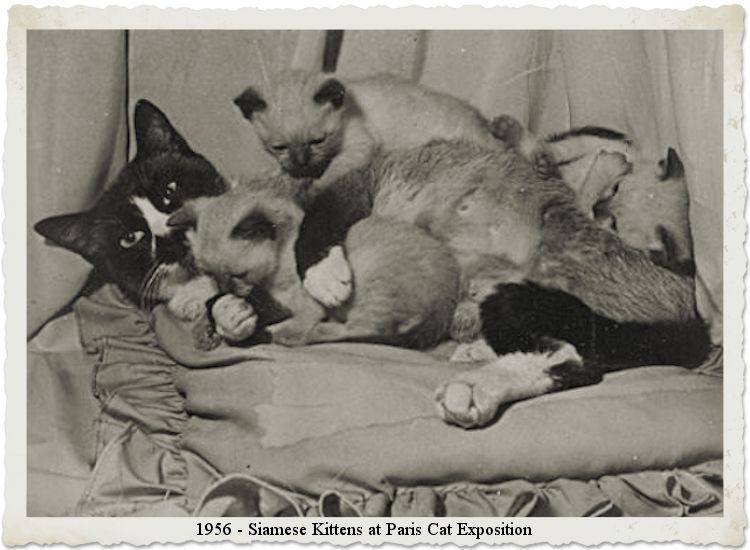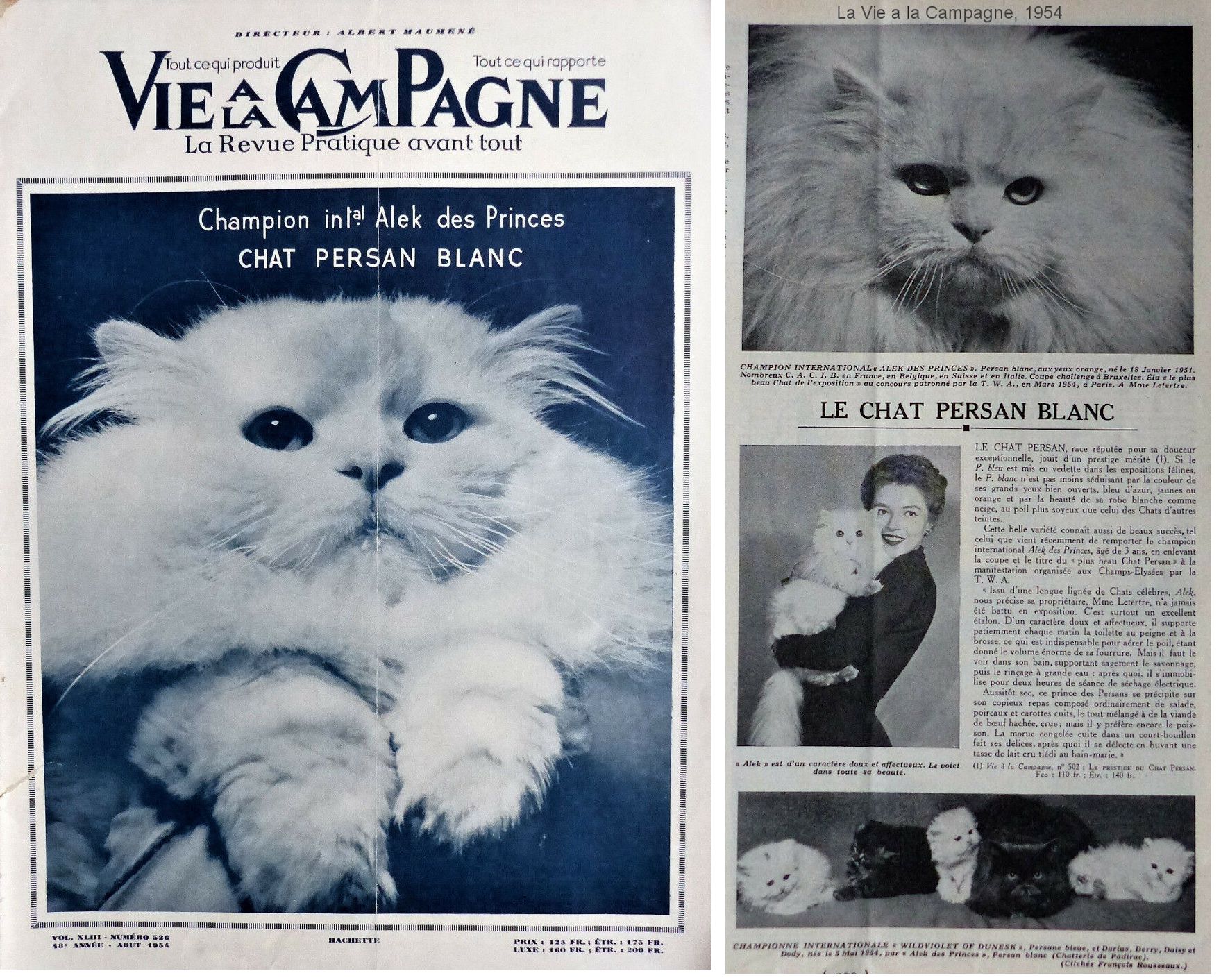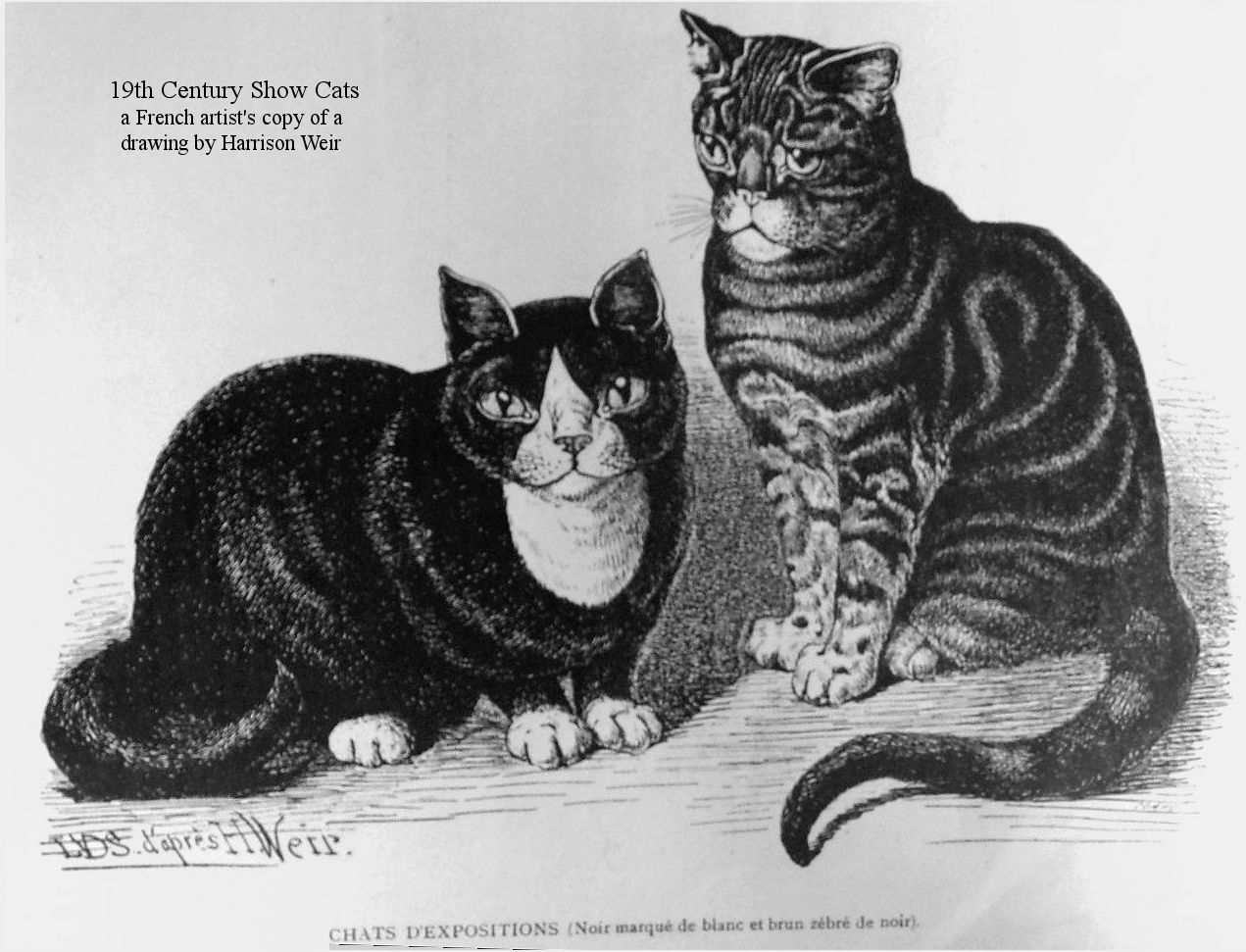
REPORTS FROM EARLY FRENCH CAT SHOWS
FRANCE
Here is a little background to the cat fancy in France. According to Kathleen Kete in "The Beast in the Boudoir, Pet-Keeping in 19th Century Paris," the cat was the anti-pet of 19th century bourgeois life due to its associations with wanton female sexuality and its outcast status, both dating back to Middle Ages witchcraft. At the same time, cats were embraced by intellectuals and bohemians. By the end of the nineteenth century it had been rehabilitated into a family pet and distinct pedigree varieties were being bred and exhibited.
The eighteenth century's most widely influential naturalist, Buffon, hated cats, viewing them as perfidious, faithless creatures and an unfaithful servants kept out of absolute necessity to hunt mice. About the only good thing he had to say about them was that they were agile, clean and liked the softest sleeping places. He claimed this was based on careful observation of their shifty demeanour, their avoidance of direct eye contact, and the sexual voraciousness of the females that forced themselves on reluctant males. Alphonse Toussenel went even further; in his Zoologie Passionnelle of 1855 he likened the need for cats to the need for prostitution. It was also widely believed that cats were subject to the spontaneous generation of rabies and could develop rabies through sexual deprivation. Rabies contracted from cats was much rarer than rabies contracted from dog bites and this was attributed to the fact that male cats might be neutered (albeit only 10% of them) and lacked tsexual urges, while female kittens were often destroyed, as well as to the fact that cats were not as sociable with humans as were dogs.
Fee wrote that if the Parisian cat could choose his own master, it would choose the artisan (where it could hunt mice) rather than the rich bourgeois (where it would become soft and too lazy to hunt). The cat was neither bourgeois nor working class, but was associated with bohemians such as Theophile Gautier, Alberic Second, Leon Gozlan, Champfleury, Theodore Barrière, and Paul de Kock. It was also the companion of literary intellectuals, as it was content to be in their company without demanding attention in the same way as a dog. Such people were apparently attracted to cats because they had "free will." Unlike dogs, which would lick a tormentor's hand, cats rarely allowed themselves to be victims of vivisection and escaped the knife of those experimenters who found dogs, rabbits and pigeons far easier to sacrifice, explained Fee. Cats were obstinate, independent and constitutionally difficult to shape to utilitarian ends. To understand the cat, wrote Champfleury, "one must be a woman or a poet." Henri Lautard likened the self-contained cat to a philosopher.
Their apparent lack of fidelity and sociability and its resistance to being trained meant cats did not fit into mainstream bourgeois life. Attempts to "rehabilitate" it took the form of extolling dog-like characteristics in the cat. Stories that featured feline fidelity appeared in the bulletin of the Parisian Societe Protectrice des Animaux in the mid-1860s. In the July 1864 issue, the society featured a brief story on the "attachment cats are capable of feeling toward us." Cats, like dogs, could be faithful beyond the grave, for example a cat whose master committed suicide apparently attempted suicide itself. When a cat attached itself to its master of mistress it might die of grief from having lost them. This theme was repeated into a children's story "Jennie and Minnie." When orphan Jennie dies of mistreatment, her kitten Minnie dies on the child's grave. Writers applauded "feminine" cats for exhibiting "masculine" dog behaviour. The Societe carried a letter in its March 1873 bulletin from M. Heine about feline fraternite." The letter mentioned twin cats that had their kittens the same day and in the same basket and who shared maternal duties. Alexandre Dumas loved his cat, Mysouff, for its canine behaviour. Each day Mysouff walked with him to work, and each day it exuberantly greeted Dumas on his return.
The cat's cleanliness and refined behaviour played significant roles in its increasing popularity. The Societe wrote in 1857. That a dog left to its own devices was a glutton and would even eat the excrement of other animals. Cats liked to be clean; dogs were quite happy to be dirty. By the 1880s, pet owners needed little convincing that cats made good pets. The cat's popularity increased greatly from then until the First World War.
Even before the Belle Epoque (which began in 1871, the same year as the first Crystal Palace Cat Show), there were cat lovers among ordinary people who were neither intellectual nor sexually unconventional. During the Paris Commune, when people had to eat or destroy their pets, some saved their cats. In the early days of the siege of Paris, when authorities attempted to save dogs from destruction, cats also had supporters. The Societe Protectrice des Animaux bulletin of 1871 tells us that more than one poor devil shared his last crust of bread with him and in one club when the motion was made to ruthlessly sacrifice pets several good souls spoke on behalf of cats as not being useless mouths, despite malicious lies about them. During the late 1870s the Societe defended cats more actively. In 1866 its bulletins carried no reports on cats. Ten years later it carried 20 reports including the need for a cat refuge. In the 1860s the Societe was concerned with preventing the hunting of Parisian cats for their fur and in demonstrating to its readers that cats could be loyal to their owners. In the late 1870s the main feline issue was the need for a cat refuge.
The appearance of cat shows in Paris and an interest in pedigree cats was a significant step towards it becoming a household pet. Cat shows, like dog shows before them, were based on British models. There was a cat show in Paris in 1869, two years before the first Crystal Palace cat show. Henri Lautard remarked in 1909 that cat shows were held annually in London, and that Paris had had several fine cat shows during the previous few years. Cat shows resulted in breed standards, again imported from Britain where Harrison Weir had codified the "points" of those breeds known in the 1880s. While dogs, which were classified according to function and judged on gait as well as on conformation, cats were classified and judged more like rabbits, based on coat and eye colour, length of coat and conformation, but not on function or gait.
The French began to be interested in perpetuating cat breeds in the late 1870s with Abyssinians first appearing in writing in 1874, and Siamese being introduced into France by the French ambassador to Siam, Auguste Pavie, who presented one to the Jardin des plantes in 1885. In 1869, Brehm had listed only eight breeds of cats in "La Vie des Animaux Illustree": the Angora (white longhair), Manx, Chinese Lop, Chartreuse (grey), Persian, Rumanian, Tobolsk (red), and the red and blue cats of the Cape. Also in the 1860s, Larousse knew of only four varieties: the domestic tiger (tabby), Chartreuse (grey cat), Spanish (tortoiseshell) and Angora (longhair white). The bourgeoisie loved to collect exotic animals and to develop distinct breeds. Some types of dog were given invented and exotic histories. Abyssinian and Siamese cats would also be given fanciful histories. By 1937, Lestrange mentioned a number of exotic breeds: Persian, Sacred Birman, Siamese, red Tobolsk, black Gambian cats, Cyprus Cats and Canadian Cats.

THE FRENCH DOG AND CAT SHOW 1869. - Pall Mall Gazette, 15 June 1869
OUR English amateurs and patrons of the kennel have found imitators on the banks of the Seine, and as the French Derby treads close on the heels of the Epsom one, so the dog show at Islington is followed by the "Grande Exposition de Races Canine et Feline" in the Rue Picot. The Rue Picot, hard by that great artery by which fashionable life ebbs and flows between the Champs Elysees and the Bois, is easy enough to find when you know wbere to look for it. But to that knowledge, as our experience goes, few of the Parisians can help you, least of all the sergens de ville or even drivers of the fiacres. What increases the difficulties of the patient explorer is that the neighbouring avenue has been rechristened. The ex-avenue St. Denis now calls itself Malakhoff: Arrived there, you find the exhibition modestly or pretentiously qualified as "English." Why it should be so it is hard to say, for with the exception of bulldogs and bull terriers, English breeds are generally conspicuous by absence or weakness, while the exhibitors are almost entirely French. On the other hand, the race feline, as the affiches have it, is represented very strongly.
In the show everything is in excellent order, although the space is somewhat confined, and you occasionally find a formidable row of teeth in perilous contiguity to your calf or shoulder. An admirable set of rules stuck up everywhere seems to be strictly attended to. One of these runs-"La toilette des chiens devra se faire avant 7 heures;" and it would appear that the dogs have no cause to be dissatisfied with their valets. There is no stipulation as to the toilettes of the cats, probably because in their instincts of scrupulous cleanliness they can be trusted to see to it themselves, and it may serve as a healthful distraction in the rare moments when they are awake. [...] Finally, there was apparently an excellent show of cats and poodles, although on the points of neither do we pretend even to hint an opinion. If we should hazard a criticism on the former, we should say the society seems to be striking out in a false direction, breeding for show and not for use. No one could suspect the corpulent sleek Angoras of compromising their dignity by active motion, and breeding and feeding must stifle instinct even if the mice came gambolling between their paws.
But from the almost invariable intimation of a vendre [for sale], we presume the real intention of the exhibition is as a market more than a competition, and if the prices asked often sound exorbitant, they are by no means intended to scare off purchasers, and the exposer remains "open to an offer."
THE CATS OF PARIS - Boston Transcript, November 1888
We are promised a cat show in Paris. This will not, perhaps, be so interesting as a baby show, but it will be a novelty here. The Parisians like cats, and, as everybody knows, they have a highly distinguished breed. Their long fur, bushy tails and amiable faces have made them celebrated as "French cats," although in reality they claim Oriental descent. At all times in favor here, they were chiefly appreciated during the siege, although the quantity of meat in proportion to fur was often disappointing. A good cat of steady habits — the profligate animals are always lean — was worth twenty francs or more a few days before the capitulation. If some old ladies had not clung to their cats with great determination, and checked their roving impulses, they would doubtless have been all eaten. Intelligence in cats grows in inverse ratio to fur. The long furred animals are sleepy and stupid, the short furred ones, with tails like rats, are active, wide awake and exceedingly enterprising. These last are known by the name of "gutter rabbits" in Paris. Perched on the roofs, safe from all stone throwers, they hail the coming of spring with jocund music, and when they roam the streets at night they make the rats' lives a burden to them. Yet, with all their claims to consideration, the "gutter rabbits" will have no place in the exhibition.
PARIS NOTES - CAT SHOW - Le Gaulois : Litteraire et Politique, Issue 3173, 7th May, 1891 [Translated from French]
A committee has just been formed in Paris to organize a cat show at the end of the month. This curious exhibition will feature the various varieties of domestic cats, from the silky Angora cat to the tabby cat, whose grey and black markings are similar to those of the tiger. On show there will also be the Chartreux breed, with its grey and shining coat, with bluish highlights, and the Spanish cat with its coat of tawny red or a mix of white, red and black. These are the four main varieties of cats which give rise to several other types of crossbreeds and non-pedigree cats.
This meeting of nocturnal virtuosos promises us some beautiful sessions of music. For, if we are to believe the opinion of some scholars, the cat is very advantageously arranged for music: it can give various modulations to its voice and nuance the expression of its song, sometimes languorous and passionate, to please the object of his love, and sometimes furiously threatening to combat the ill-intentioned advances of an abhorred rival. The cat has friends and enemies. We rank ourselves among the former. It is true that our admiration is somewhat suspect of presumption and vanity. The philosophers of the eighteenth century affirmed, in fact, that the marked preference of some people for the cat was indicative of a higher merit. Let him be forgiven for so much pride. Many people, artists, scholars, have a marked predilection for the feline. What they like about this creature is its independent nature and self-centred character. They prefer the ingratitude of the cat over the servile meanness of the dog; the cat does not know how to remember the benefits it has received. The cat pleased those the delicate and refined natures that find, with reason, that the dog is too bulky, coarse, heavy and clumsy, lacking, in the last analysis, good manners. However, the cat is something else. They admire its flexibility of movements, its sobriety of gestures, the lightness of its graceful approach - discreet, full of good taste. The cat never departs from its calm and collected attitude. It appears in the most sumptuous living room the same as it is found in Mrs. Cardinal's lodge.
The poets celebrated its glory and sang its praises. Baudelaire wrote four plays about cats. We all remember his verses of fervent lovers and austere scholars in their mature season, the high-bred and sweet cats, the pride of their house, who are as sensitive and sedentary as themselves. Buffon has violently, and probably unjustly, attacked the cats. "The cat," he wrote in a fit of temper," is an unfaithful servant that we keep only from sheer necessity. " Rivarol also threw the sharp sting of his irony against him "Cats don't caress us - they caress themselves on us."
We could multiply endlessly the witticisms, the remarks and the observations that have been made throughout time about the cat. Montaigne admits that he took great pleasure in the games of his cats. He always had three or four -and he added that it was recreation as well as study for him. Fontenelle, the author of the plurality of worlds, had an eccentric quirk; he placed one of his cats in a chair and gave speeches to him with great seriousness. "It was," he said, "to practice speaking in public." Mrs De la Sablière suddenly fell in love with cats, replacing her dogs with just as many cats.
We know the rondeau composed by the Duchess of Maine on the merits of her cat Marlamain, and especially the famous quatrain that Mme de Lesdiguières had engraved on the white marble mausoleum of her pussy:
A Pretty Cat.
Her mistress, who loved nothing,
Loved her to madness.
Why do you say that? You can plainly see it.
Madame Deshoulières was also fond of cats. When my husband goes away, she said, "Grisette is enough for me." It was a pretty little female puss with a white coat spotted with black.
Closer to home, we can cite, among the admirers of the cat Theophile Gautier, Leon Gozlan, Champfleury, Theodore Barrière, Alberic Second, Paul de Kock, not forgetting Baudelaire. Baibey d'Aurevilly had a great affection for his black female cat Demonette. Mr. Renan has a magnificent angora, in honour of which M. Taine composed a sonnet each day. François Coppee lives in his apartment in the Rue Oudinot, surrounded by several cats that come to play with the tip of his pen when he writes. Bourget also had a cat that he liked very much and who was called Don Juan. The cat very suddenly disappeared from his home. Perhaps had he found his Elyire and run off with her. In any case, the author of Mensonges never again saw Don Juan. It is true that Noiraud [Blackie], his faithful black dog, replaced the ungrateful Don Juan.
We have said that cats have often been celebrated by poets. The painters also crushed their pigments in honour of cats. Among the most famous paintings that represent cats, one must mention those of Gerard Dov, Paul de Vos, Basan, Teniers, Hamillon, Barlow, David de Noter, and Verlat. Lambert, the distinguished painter of cats, has made several charming compositions, among them the delightful scene exhibited at the Salon of 1865, entitled A Clock that advances. He depicted a family of young cats playing with the weight of a clock and it gave the impression of accelerated movements that had nothing to do with regularity. And now that I have praised you, dear puss, do not scratch my hand today when I have the pleasure of visiting your cat show. Otherwise, I will be obliged to publicly disclaim everything I have just said about you.
CAT SHOWS (OUR FRIEND THE CAT, PAUL MEGNIN, Published 1899)
In France most of the domestic animals which we honour with our respect and friendship are endowed with special clubs which devote themselves to their advancement, take care of their interests, defend them against all comers, sponsor them in the newspapers, and periodically erect altars and pedestals in the form of exhibitions which enthusiasts never miss. Until 1896 the cat was an exception, although the canary had attracted the united forces of his admirers into a strong group. The honour of organising the first real feline exhibition in France belongs to Fernand Xau, director of the Journal, and to M. Porte, director of the Zoological Gardens of the Bois de Boulogne.
As for the Paris show organized by the Journal, at the Zoological Garden, it was, we may say, a remarkable success: more than four hundred cats were exhibited, and, as for visitors, on the last day we counted fifty thousand entries into the Garden!
It must also be said that it was an innovation, being the first exhibition of its kind in Paris. Plus the setting was wonderful, and as one of the judges, Mr. Lhoest, the friendly director of the Zoological Garden of Antwerp, said: "If the Palmarium of the Zoological Garden was located closer to the centre of Paris, no city in the world could hold anything like it." The elegant cages that housed the cats were in the middle of a real tropical garden. Mr Porte himself, the amiable director of the Zoological Garden, presided over the installation of his temporary guests with his usual solicitude.
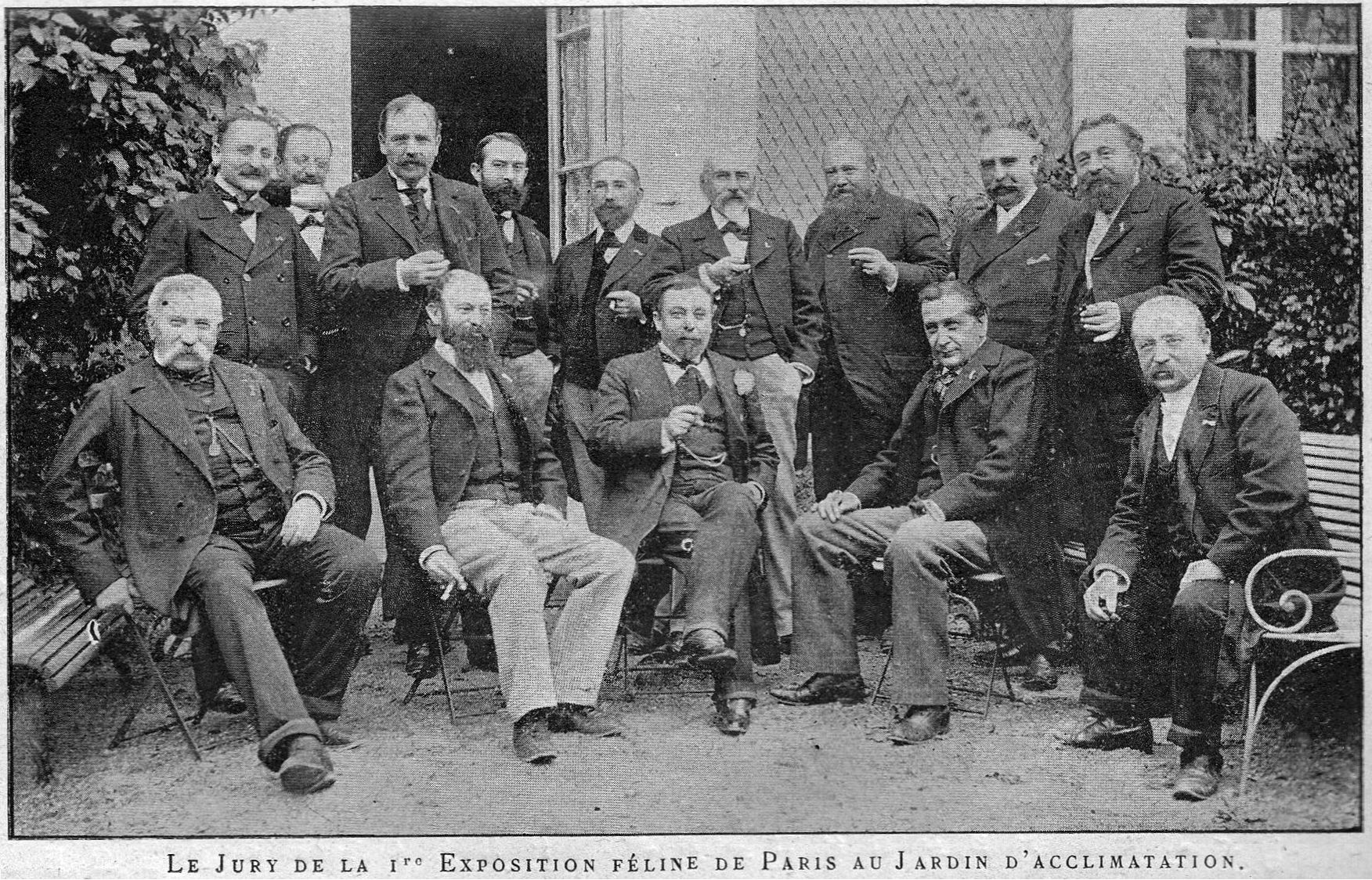
The composition of the jury was truly exceptional: Mr F. Coppee, of the French Academy; Mr Catulle Mendes, Mr A. Theuriet, Mr A. Sylvestre, Mr O. Mirbeau, Mr E. Lambert, Deschaumes, Mr A. Porte, Director of the Zoological Garden, Mr Lhoëst, director of the Zoological Garden of Antwerp; Mr Pierre Megnin, of the Academy of Medicine; the artist Steinlein and Mr Maurice Vaucaire.
What caught the visitors' attention was the category of foreign cats and wild cats. In this category were felines that may not have been true cats, including a Serval, a really fierce animal that it would have been dangerous to stroke; moreover, he warned away the world with his characteristic hissing. On the other hand, in the same category there was a small Cayenne Leopard, presented by Miss Dufresne, and this was gentle, affectionate and playful like a real cat.
The foreign domestic cats were mostly represented by Siamese cats, about ten in number, so pretty with their pale coffee coloured coat and black muzzle, ears, legs and tail. This category should have been completely separate from the others; because Madame Waldeck-Rousseau's pretty Siamese family comprising father, mother and the little ones would have had gained first prize, but they only got a second prize because Miss Dufresne's little leopard took first prize!
Among the native cats, all Parisians, most of them were neutered cats which, due to this operation, had generally attained colossal sizes. It is one of those cats, a beautiful Angora it is true, who had the first grand prize of honour; the second grand prize was awarded to a beautiful tabby entire male, a true model of conformation and colour, and in our opinion, he should have had first prize because the breeding cats must always be placed ahead of the eunuchs in a show aimed at encouraging the production of beautiful breeds.
Many owners of beautiful cats had abstained, hesitant, not knowing exactly what the judges were looking for. Now they are able to fix on the direction to take in breeding, which offspring to choose from the litters resulting from random encounters on the eaves.
Thus the Paris cat Show was founded; it is now held regularly every year. The first show, despite the speed with which it was organized, succeeded very brilliantly.
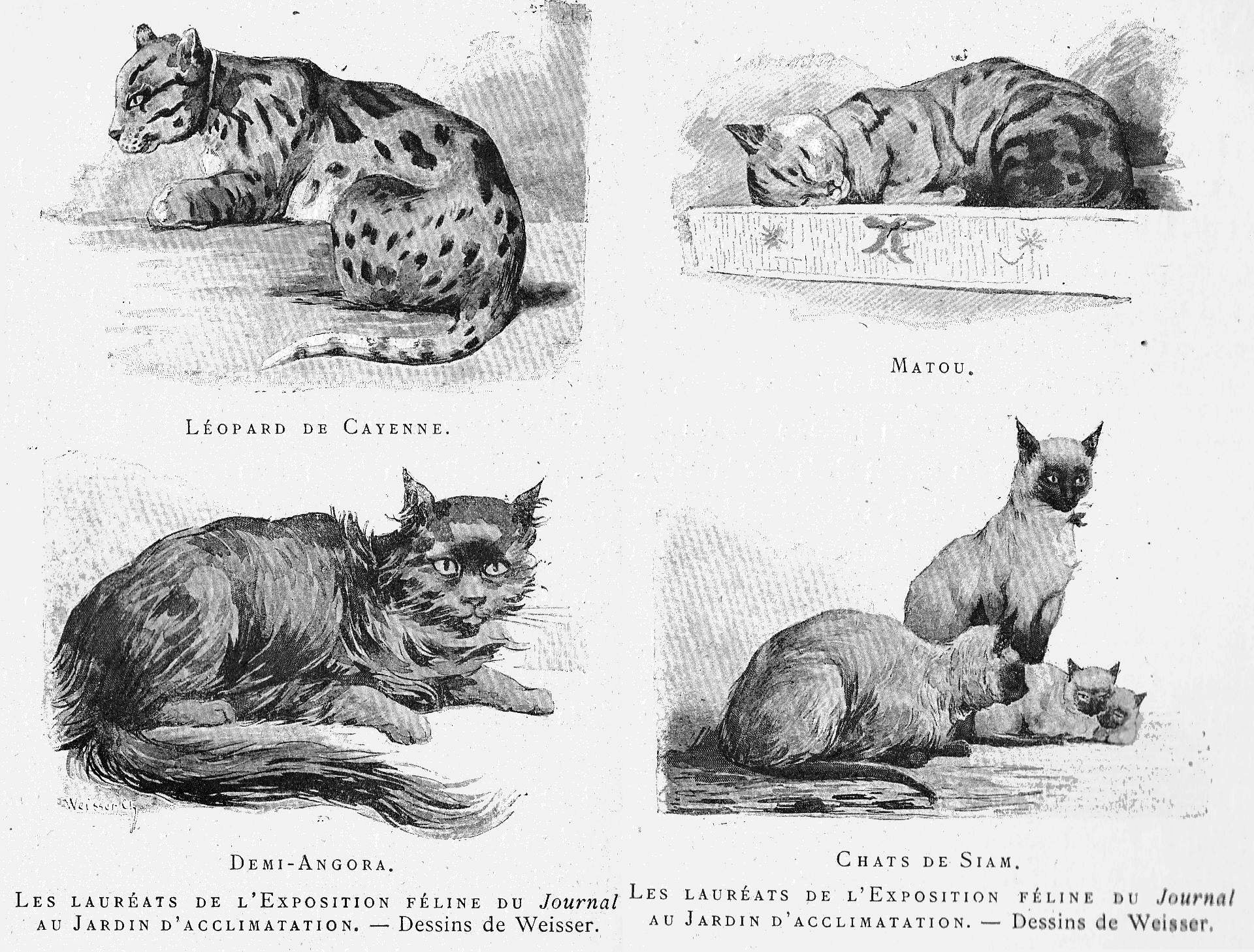
The winning cat owners at the first cat show in Paris were:
First Grand Prize of Honour, Mr. Lesy.
Second Grand Prize of Honour, Mr. Khil.
Grand Prize offered by the Zoological Garden - Gold Medal, Grand Module [25 centimes], Mr. Weil.
Special prize awarded to the best domesticated cat, offered by Mr. Vadon. - Miss Dufresne.
It remains for us to hope that we will not stop on this good path. Now that cat shows are held every year in Paris, cat lovers will be able to get together and found not just a society for the improvement of cat breeds, but at least one club for French cat lovers. Similar societies have existed for several years in England, Belgium, and Holland, where they are flourishing.
PROPOSED CAT SHOW IN PARIS. A NOVELTY FOR THE FRENCH CAPITAL. Pall Mall Gazette, 5th September 1896
Our Paris correspondent writes :-On the 25th of this month it is proposed to open a great International Cat Show at the Jardin d'Acclimatation - the Paris Zoological Gardens - to which cats of every breed and colour will be admitted, gold, silver, and bronze medals being awarded to the handsomest beasts in each class. Paris has already her annual dog show, which has come of late years to have an International importance, but it has been left to the enterprise of a daily paper,: Le Journal, to make amends for the indifference with which cats have hitherto been treated. One grand gold medal is specially reserved for wild and foreign cats, such as those of Siam, of Archangel, and of Madagascar. It is expected that the tortoiseshell, or as the French call it the tricolour, cat will make a brave show. The judges will be M. Pierre-Amedee Pichot, editor of the Revue Britannique, one of the founders of the National Acclimatation Society, M. Raoul de Najac, whose passion for cats is well known, and M. Porte, the director of the Zoological Gardens. The show will be open for three days.
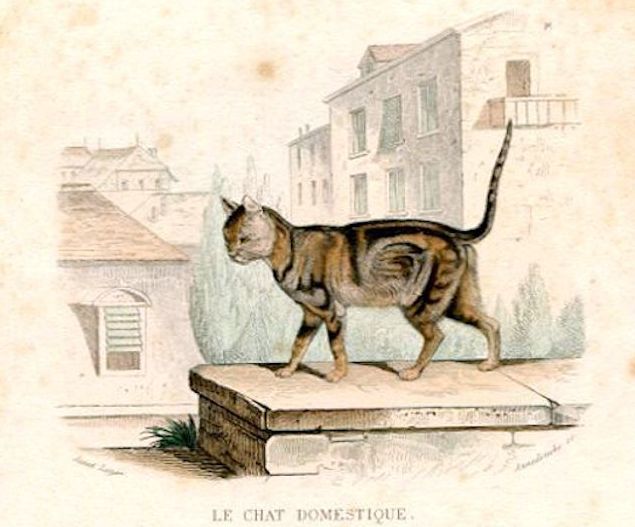
CAT SHOW AT THE JARDIN D'ACCLIMATATION 1896 - The Times Picayune, September 24, 1896
Buffon hated cats. "When they are young," he wrote, "they are gentle enough, but they have an innate malice, a natural falsity and perversity which age increases, and education cannot remove." On the other hand, Balzac was a cat-lover, and Zola is among their best friends. On the 25th of this mouth a great international cat show will be opened at the Jardin d'Acclimatation, to which cats of every breed and color will be admitted, gold, silver and bronze medals being awarded to the handsomest beasts in each class, says the Paris Messenger. The Journal is responsible for this brilliant idea. One grand gold medal is specially reserved for wild and foreign cats, such as those of Siam, of Archangel, and of Madagascar. It is expected that the tortoiseshell, or, as the French call it, the tricolor, cat will make a brave show. The judges will be M. Pierre- Amedee Pichot, editor of the Revue Britannique, one of the founders of the National Acclimatatlon Society; M. Raoul de Najac, whose love of cats is well known, and M. Porte, the director of the Jardin d'Acclimatation. The show will be open for three days.
[PARIS CAT SHOW] American Register, 26th September 1896
The great Cat Show, which opened yesterday at the Jardin d'Acclimation, and will continue until to-morrow night, promises to be a remarkable success. The members of the jury are MM. Francois Coppee, Emile Zola, Andre Theuriet, Armand Silvestre, Eugene Lambert, E. Deschaumes, F.L. Hoest, A. Porte, and P. Megnin.
[PARIS CAT SHOW] Civil & Military Gazette (Lahore), 24th October 1896
A cat show is being - organised at the Jardin ci'Acclimatation. Tabby cats, tortoiseshell cats, black cats (possessed of the devil), long-furred cats and short furred cats will be caged up for several days for the entertainment of the public, but to their own inexpressible disgust. Cats in France have been the delight of many eminent men, and they have also had their poet. His name was Charles Cross, and all cat-lovers will keep his memory green for the sake of these lines:
Chatte blanche, chatte sans tache,
Je te demande, dans ces vers,
Quel secret dort dans tes yeux verts,
Quel sarcasme ta moustache?
The French show of 1897 included a display of mousers, possibly giving a demonstration of their prowess. You'll note that the same Roedel painting is used for the 1898 and the 1900 show.
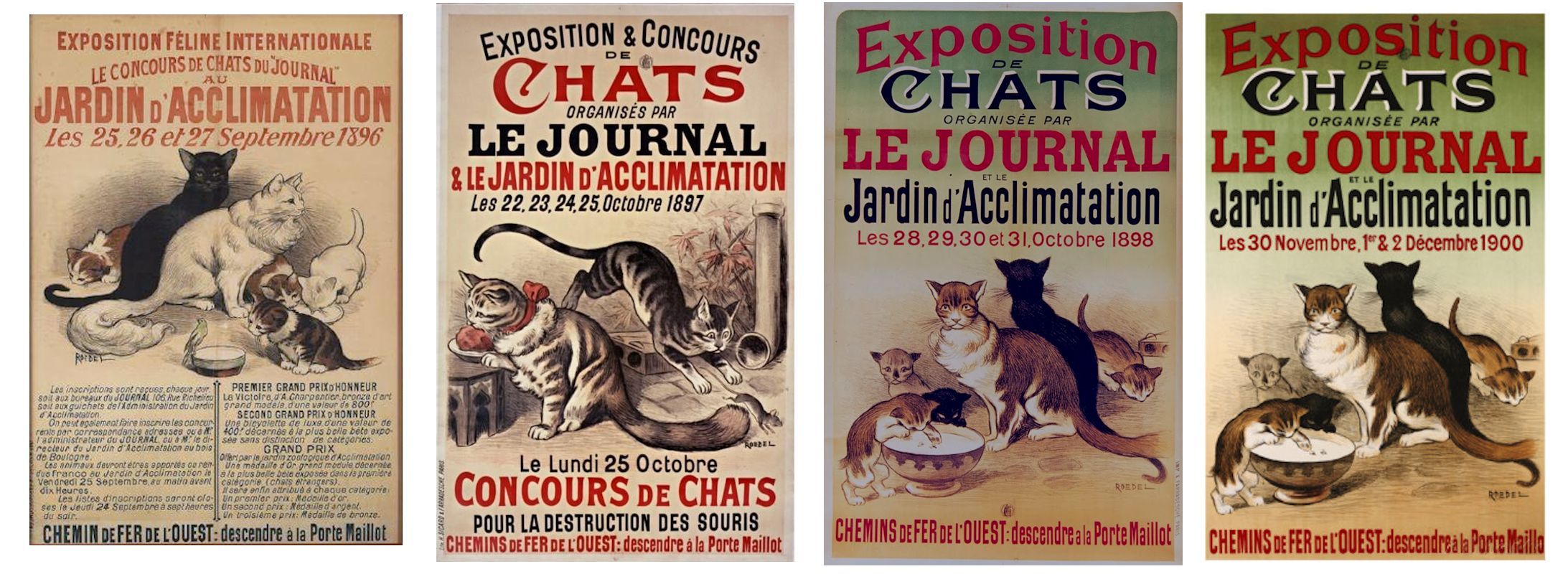
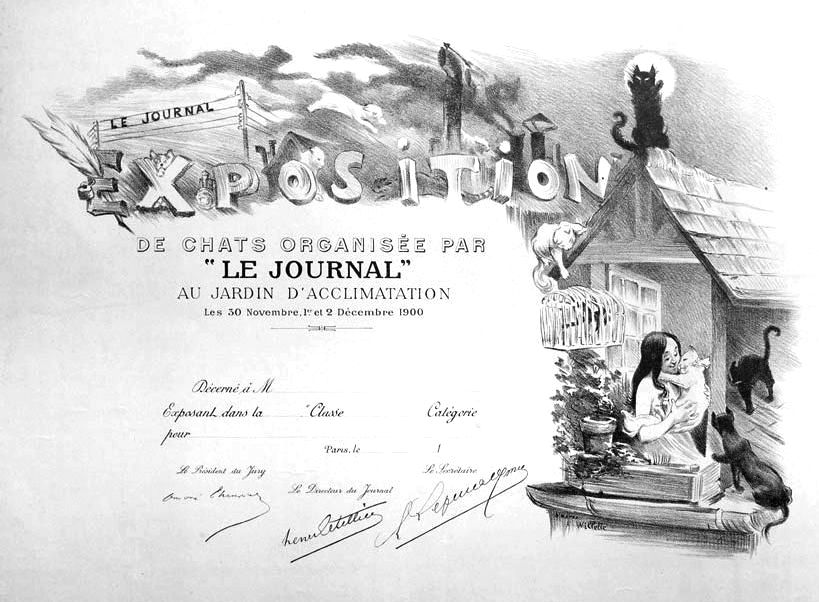
CAT SHOW IN PARIS PROVES A MOST GRATIFYING SUCCESS
Frenchmen of International Fame Are Interested. Zola, Silvestre, Coppee, Lambert, and Steinlen Are Members of the Jury on Awards.
The Inter Ocean, November 2nd, 1896
As fond as the French are of cats, this exposition, given under the auspices of the Jardln d'Acclimatation and the morning paper ‘Le Journal', is the first cat show that has ever been held in Paris. For weeks the papers have been full of it, and every prominent litterateur in France has been interviewed as to his opinion regarding canine [sic. Should be feline?] pets.
Alphonse Daudet was the only one to affirm his dislike of them. He had had a positive fear of cats, he says, since when [as] a small child he was left alone in a darkened room to hear mysterious noises from the supposed to be vacant salle adjoining. These sounds, which culminated in the strange discordant playing of a piano, came from a stray cat that had entered through an open window, but he has never forgotten the shock they gave him. Francois Coppee has furnished a whole article on the subject of his particular Mimi, regretting that, as he had promised to serve on the Jury, be could hardly expose [exhibit] it, and then consoling himself with the philosophical reflection that the little friend he thought so charming was not to be exposed to the less biased opinions of others. It is only to be expected that Pierre Loti, that charming writer of cats, should have many anecdotes to relate of his household of canine [feline!] pets. Mlle. Moumotte or Mon. Mimi, as they are all called, for the imaginative writer professes to have little imagination in regard to cat surnames, and only distinguishes them as Mimi Gris, or Moumotte Blanche.
Perhaps it is well to explain that a nice tabby cat has, generally speaking, no right to the name of Mimi, and it is only an eccentricity in our household to speak of our cat as a gentled demoiselle. We know it is bad French, but we have always done it, although she is not in the least a "new woman." Besides, we know of a fox terrier that answers to the gentle name of Mollie because his mistress, thinking him to be an English dog, has given him the only English name she knows. By the way, our Mimi has another name, quite a proper one, meaning "little love," but she always looks upward when she hears it, for it is only used by our kind neighbor above and means that choice bits of chicken are going to drop down on the balcony tightly rolled in a bit of paper like Christmas bon-bons.
A friend of Ernest Renan's tells of his love for cats; of his having portraits done of them by celebrated painters, and how distressed he was when, on moving to a new apartment, his pet cat was discontented. Zola, when asked for his opinion, said he was an ardent admirer of them and pointed to the number of cats that figure prominently in his books. Writers who have no cats of their own to tell fabulous stories of are going into history and relating the doings of the cats of Richelieu, to which the great Cardinal and statesmen left various plump legacies; for cats and cats' stories are very popular with us just now. This series of interviews has included the opinions of some public women, but women hardly appear to be as fond of cats as men. They are prone to cite the faithfulness and affection of dogs.
Not the least interesting feature of the cat exposition was the morning when we waited for two long hours while the cats were being entered, some half a dozen at a time, to be arranged in their separate cages among the palms in the large building allotted to them. As one entered there was a cborus of gentle meows, but, as a rule, the cats were much more patient during the long, tedious waiting than were those in charge of them. How patient they were! Large cats curled up in small baskets, mother cats with whole families confined in a cruelly small space, and even chats sauvages in wicker cages as gentle as — well, as gentle as cats — except that they sometimes tore up the bits of straw on the bottom or rebelled in tiger-like movements against their unaccustomed confines. We felt quite proud that our cat was the only one, save a very few small kittens that had been brought without basket or cage, and that for four long miles she sat primly behind the cogher and surveyed the pouring rain and with distant admiration the great world that she had never before seen.
When the various cages were arranged the large palm house, which is the popular resting place in the Jardin - for there is a music hall on one side, and it leads to a tropical conservatory on the other, where there are many round tables covered by the morning papers — the effect was charming. The cages were placed in long avenues separated by rows of palms, and there was a nice, comfortable house for each little cat. Each owner was allowed to decorate his particular cage as he chose, but, fortunately for the general effect there was little attempt in this direction save colored cushions on which these pampered pets might recline. To be sure one cage that contained a family was fitted up with blue couches and window draped with curtains, and a wee Angora, with hardly two months of life, had a blue-lined basket to match his blue eyes, and neck ruche, and a blue worsted ball swung by a ribbon from the top of the cage. There was such a lot of Angoras and semi-Angoras, great fluffy creatures generally stolid of demeanor and uninteresting save for beauty. One who claimed the medallle d'honneur was a superb creature that must have weighed twenty pounds, pure black, with topaz eyes, bushy tail, with bunches of fur on ears and thick ruche at least three inches deep.
The foreign cats, or chats savages, were naturally the most interesting feature. A sleek Siam cat with gentle head, short ears, and a slight coat of silky yellow fur that turned to golden brown on the paws, little nose and ears, was the proud mother of four little mouse-like babies. Another cat had a velvet coat striped like a tiger's, hut much more beautiful. He was after all a gentle little animal, glorious with a broad band and bow of red satin, and quite willing to respond by playful bitings to the compliments showered upon him. Over three of the cages stretched additional wires of fine mesh, and the sign of "Dangerous." Two of these were occupied by fierce-looking animals superbly striped with yellow and black. "Mais ce n'est pas un chat, c'est un tigre," said the crowd gazing at the feroclous-looklng animals that one certainly would not wish to encounter alone. The third cat marked as "dangerous" was a tiny animal, something in shape between a weasel and ordinary cat, and beautifully spotted in tints of brown and yellow [a genet?]. But tiny as he was, he paced his cage with the movements of a leopard. Some of the short-haired cats were wonderfully beautiful in regard to form and coloring, and received much attention. Indeed, after the doors were open to the general public the place was so crowded that one could with difficulty make the rounds.
The show, however, has been a great success, and Le Journal promises to repeat the experiment next year. Look at the list of prizes! A bronze by Charpentier, a bicyclette, and any amount of gold and silver medals! And the jury on awards, that comprises the names of Emile Zola, Armande SIivestre, Francois Coppee, and Lambert and Steinlen among the artists, who paint cats, is sufficient to give distinction to any undertaking. Even with Paris en fete for her "Russian party," the exposition feline has had an importance share in public interest. (From the Boston Herald)
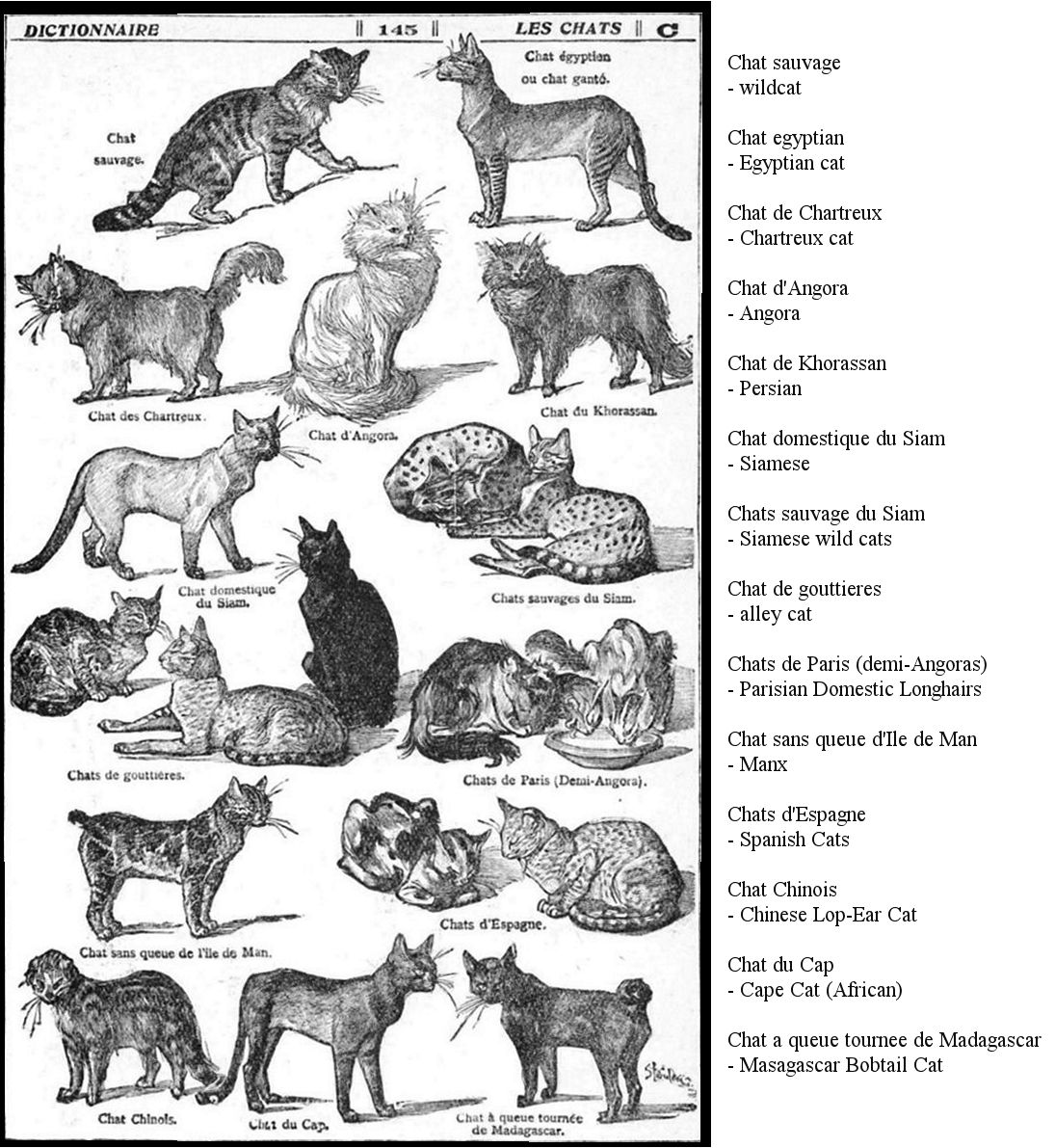
[PARIS CAT SHOW] Hants and Sussex News, 10th February 1897
M. CFrancois Coppee's fondness for cats as pets is so well known that there was great fitness in placing his name first upon the jury of awards at the recent cat show in Paris. Such other well-known men as Emile Zola, Andre Theuriet, and Catulle Mendes ' also figured on the list. There will be an annual 'Exposition Faille Internationale."
CAT SHOW Herts & Cambs Reporter & Royston Crow, 12th February 1897
Mr. Francois Coppee's fondness for cats as pets is so well known that there was great fitness in placing his name first upon the jury of awards at the recent cat show in Paris. Such other well-known men as Emile Zola, Andre Thouriet, and Catullo Mendes also figured on this list. There will be an annual "Exposition Feline Internationale."
MOUSE HUNT IN PARIS. South Wales Echo, 1st October 1897
This year's cat show at the Jardin d'Acclimatation will (says a Paris correspondent) have the additional attraction of a mouse hunt in the Palmarium on October 25th. The first prize will be 300f. in money, the owner of the second successful competitor receiving an artistic bronze statue entitled "La Victoire." The exhibition itself will be opened on October 20th. Owners will pay 3f. entry for each cat, a reduction being made where kittens accompany their maternal parent.
PARIS CAT SHOW St. Andrews Citizen, 23rd October 1897
At the Paris Cat Show this month is has occurred to the promoters to introduce a novel feature. Hitherto it has not been thought possible to get any sport out of cats, or, at least, none which the authorities regard as legitimate; but at Paris it has been arranged to hold a mouse hunt in the Palmarium of the Jardin d'Acclimation in connection with the cat show. According to the rules, it is to be a coursing match, and two cats are to be loosed in sight of the mouse, let free with in an enclosed space. Great sport is expected, which will no doubt be realised, especially if the lively mouse, with its usual ingenuity, finds a way of escape in the barrier which protects lovely and helpless women from its wild rush.
[PARIS CAT SHOW] Indian Daily News, 28th October 1897
There is going to be a new feature in the Pris Cat Show. It is going to be made more practical, and a 300 francs prize has been instituted for the best mouser. The conditions of the competition are being arranged, and will be run off something like the Waterloo Cup. The palm-house of the Jardin d'Acclimatation has been selected, and there ought to be some very clever doubling. A cat who could get a mouse out of a bamboo clump would be domestic treasure. The education of the domestic cat has been very much neglected, and is still in much the same rudimentary condition as it was twenty years ago, when five minutes in a bird cage playing with the canary who fired a cannon, was the utmost limit. The vast wave of education which is sweeping over the civilised world is affecting every one of the lower animals, and every circus produces monkeys and elephants and dogs who are distinct advances on the past, and marvels of erudition. The cat alone, like the Indian Mahomedan, refuses to learn anything.
PARIS CAT SHOW. Various, November 7th, 1897 Paris is to have a cat show of a unique character. It is the "Exposition Feline," to be hold at the Jardin d'Acclimation Oct. 22, 23 and 24. It is the second annual "concours de chats," or cat concert, and, considering the great number and variety of cats to be found in Paris (where the jokes about the identity of alleged rabbit at certain restaurants are not altogether jokes,) the convention should be a success. But the feature of the cat show is the mouse-killing contest. The cat that can kill the greatest number of mice in a given time will be declared the winner, decorated with the red ribbon of the cat's legion of honor, and endowed with a money prize or object of art for the benefit of the owner.
Tom will be placed inside a room of certain size, and provided with the mice at a rate suiting his killng power. There will be no rats In the game. Some of the rats in Paris are as large as small cats and there could be only one result of an encounter between a languorous cat from the Champs Elysees and a ravenous rat from the sewers. Cats and dogs In Paris are near to the hearts of the people; they are never abused. The cat is scarcely ever troublesome, but the French capital is sorely in need of a piper or a pound-master who will entice the dogs away. The cat show in question ought to be a dog show and the contest should be between the dogs themselves all at a time, the bell to be rung* when only a few of the choicer grades of dogs remained surviving. J. M. ERWIN.
[PARIS CAT SHOW] American Register, 29th October 1898
The Cat Show, arranged by the Administration of the Jardin d'Acclimatation, opened last evening under brilliant auspices, and promises to be a great The whole of the Winter Palace, with the hothouses, the large Winter Garden, and the Palmarium were lighted by electricity, and presented a fairy-like appearance.
[PARIS CAT SHOW]American Register, 8th December 1900
The Cat Show, which was organized by the Journal, and held in a pavilion at the Jardin d'Acclimatation on Saturday and Sunday last, was one of the best and largest seen here of late years. There were no less than 335 numbers, an among them several very rare and beautiful specimens. The attendance during the two days was a very numerous one.
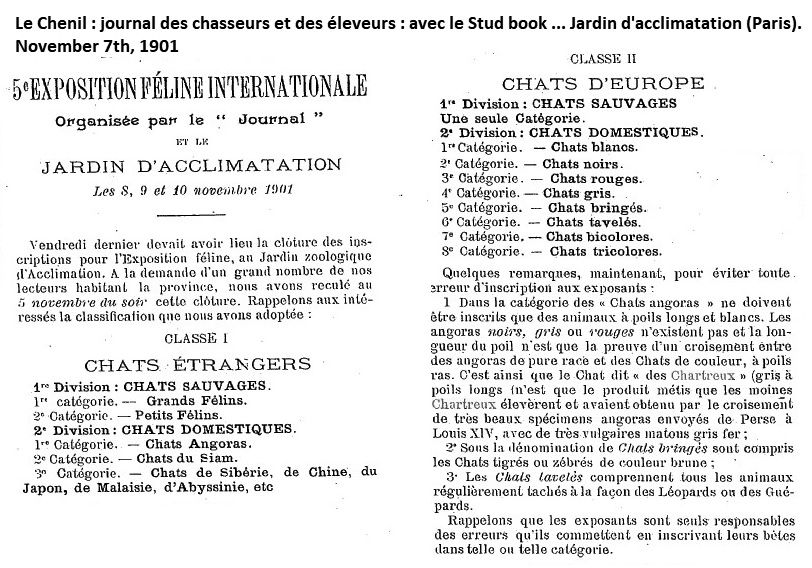
5th INTERNATIONAL FELINE EXHIBITION
Organized by the "Journal" and the Jardin d'Acclimatation
November 8, 9 and 10, 1901.
(Le Chenil: hunters and breeders' newspaper: with the Stud book… Jardin d'Acclimatation (Paris). Le November 7th, 1901)
Registrations for the Feline Exhibition in the Zoological Garden of Acclimatation closed last Friday. At the request of a large number of readers living in the province, we postponed this closure to the evening of November 5. Let us remind those interested of the classification we have adopted:
CLASS I - FOREIGN CATS
1st Division: WILD CATS.
1st category. - Big cats.
2nd Category. - Little Felines.
2nd Division: DOMESTIC CATS.
1st Category. — Angora Cats.
2nd Category. - Siamese cats.
3rd Category. - Cats from Siberia, China, Japan, Malaysia, Abyssinia, etc.
CLASS II - EUROPEAN CATS
1st Division: WILD CATS
Only one Category.
2nd Division: DOMESTIC CATS.
1st Category. - White cats.
2nd Category - Black cats.
3rd Category. - Red cats.
4th Category. - Grey cats.
5th Category. - Brindled cats.
6th Category. - Spotted Cats.
7th Category. - Bicolour cats.
8th Category. - Tricolor cats.
Now some few remarks, now, to avoid any errors in exhibitor registration:
1st - The "Angora cats" category is only for animals with long, white hair. Black, grey or red Angoras do not exist, and hair length is only proof of a cross between an Angora and coloured shorthair cats. Thus so-called "Chartreux" cat (grey with long hair) is only the mixed product obtained and bred by Carthusian monks by crossing very beautiful Angora cats sent to Louis XIV from Persia, with very common iron-grey tomcats.
2nd - "Brindle cats" comprises brown cats with tiger stripes or zebra stripes.
3rd - "Spotted Cats" includes all those with regular spots like the markings of the Leopards or Cheetahs.
Remember that exhibitors are solely responsible for the errors they make when registering their animals in such and such a category.
1902 JARDIN ZOOLOGIQUE D'ACCLIMATATION CAT SHOW - L'Eleveur (The Breeder), Combined with Hunting and Sports Magazine, Illustrated Weekly Newspaper of Animal husbandry, Acclimatization, Hunting, 1902
COMPETITIONS AND EXHIBITIONS
FELINE EXHIBITION organized by the "Journal" and the Jardin d'acclimatation, on November 14, 15 and 16, 1902. General Information. - The Cat Show which will take place at the Acclimatation Zoological Garden on the dates indicated above, will be held according to the following classification:
CLASS I - FOREIGN CATS
1st division - Wildcats
1st category. - Big cats.
2nd category. - Small cats.
2nd division - Domestic cats.
1st category. - Angora cats.
2nd category. - Cats of Siam.
3rd category. - Siberian, Chinese, Japanese cats, etc.
CLASS II - EUROPEAN CATS
1st division: Wild cats.
Only one category.
2nd division: Domestic cats,
1st category. - White cats,
2nd category. - Black cats.
3rd category. - Red cats.
4th category. - Gray cats.
5th category. - Brindle cats.
6th category. - Spotted cats.
7th category. - Two-tone cats.
8th category, - Tricolor cats.
Furthermore, here are the regulations for the Sixth International Cat Show:
1. The registration fee is five francs per kitten for an adult animal, male or female, and one franc per kitten. This registration fee includes accommodation in appropriate cages and food for the animals throughout their stay at the Exhibition.
Registrations will be received from today, either at the Journal offices, 100, rue de Richelieu, or at the administration of the Jardin Zoologique d'Acclimatation, until November 5 inclusive. Animals can be registered by mail by sending letters and money orders to the two addresses indicated above. Exhibitors must, of course, specify in their declaration the category in which they wish to have their cats compete.
2. Animals must be brought or returned free of charge to the Jardin d'Acclimatation on November 14th, before nine o'clock, except those which will be sent by rail and which must be sent in accordance with the following instructions:
Make shipments by trains arriving at Paris station on the morning of November 13, early, because the drayage service delivers packages arriving first thing before noon to the Jardin Zoologique d'Acclimatation.
When the shipments arrive at the station after the departure of the goods cars, they are taken to the Bois de Boulogne only in the evening and, consequently, the animals cannot be unpacked the same day. It is expressly recommended to notify the day before the parcel's departure. Finally, to avoid any delay in the delivery of animals sent to the Jardin Zoologique d'Acclimatation, we are asked to word the addresses attached to the packages as follows: Mr. Director of the Jardin d'Acclimatation, at home, Paris.
3. Owners must collect their animals on Monday, November 17, before noon; under no circumstances may cats be removed before Sunday, November 16, at half past five, the closing time of the Exhibition. As for the rewards. they will be as numerous as in previous years. They will consist of cash prizes, medals, art objects and artistic diplomas.
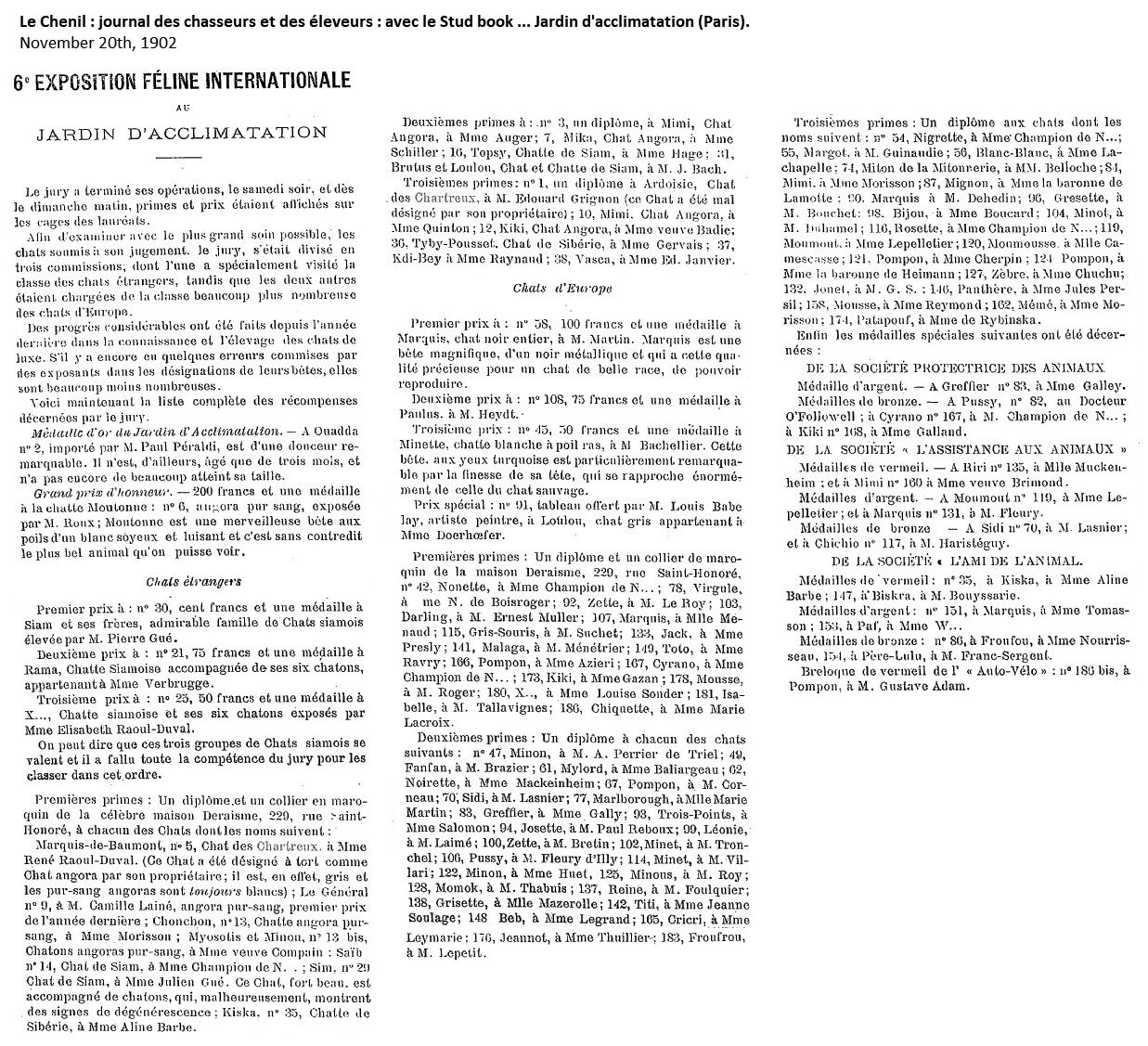
6th INTERNATIONAL FELINE EXHIBITION
At the Jardin d'Acclimatation
(Le Chenil: hunters and breeders' newspaper: with the Stud book… Jardin d'Acclimatation (Paris). November 20th, 1902)
The jury finished its operations on Saturday evening, and as of Sunday morning, awards and prizes were displayed on the winners' cages. In order to examine with the greatest possible care cats subject to judging, the jury was divided into three commissions, one of which was specifically in charge of the foreign cat class, while the other two were responsible for the much larger class of European cats. Considerable progress has been made since last year in the knowledge and breeding of luxury cats. If there are still some mistakes made by exhibitors in the designations of their animals, they are much less numerous. Here is the complete list of awards given by the jury.
Gold medal from the Jardin d'Acclimatation. - To Ouadda, Entry No 2, imported by Mr. Paul Peraldi. He is remarkably sweet and is, moreover, only three months old, and has not yet reached his full size.
Grand Prize of Honour. - 200 francs and a medal to the female, Moutonne, Entry No 6, thoroughbred Angora exhibited by M. Roux. Moutonne, is a wonderful creature with silky, shiny white fur and is without question the most beautiful animal that we may see.
Foreign Cats
First prize: No 30, one hundred francs and a medal to Siam and his brothers, an admirable family of Siamese Cats bred by Mr. Pierre Gue.
Second prize: No 21, 75 francs and a medal to Rama, Siamese female cat accompanied by her six kittens, belonging to Mme Verbrugge.
Third prize: No 25, 60 francs and a medal to X… [ presume name not known] Siamese female cat and her six kittens exhibited by Mrs. Elisabeth Raoul-Duvel.
We can say that these three groups of Siamese Cats are worthy winners, and it took all the skill of the jury to classify them in this order.
First bonuses: A diploma and a Morocco leather necklace from the famous Maison Deraisme, 229, rue Saint-Honore, to each of the following cats:
Marquis-de-Baumont, No 5, Chartreux cat, Mrs. Rene Raoul-Duval. (This was wrongly entered as an Angora Cat by its owner; it is, in fact, grey and the Thoroughbreds Angoras are ALWAYS white);
The General, No 9, to Mr. Camille Laine, thoroughbred Angora, first prize winner last year;
Chonchon, No 13, thoroughbred female Angora, to Mrs. Morisson;
Myosotis and Minon, No 13a, thoroughbred Angora kittens, widow Compain;
Saïb, No 14, Siamese cat, Mme Champion de N.. ;
Sim, No 29, Siamese cat, Mme Julien Gue. This very beautiful Cat is accompanied by kittens, which, unfortunately, show signs of degeneration;
Kiska, No 35, Siberian cat, Mme Aline Barbe.
Second bonuses: No 3, a diploma, to Mimi, Angora cat, Ms Auger;
No 7, Mika, Angora cat, Ms Schiller;
No 16, Topsy, female Siamese, Mme Hage;
No 1, Brutus and Loulou, male and female Siamese cats, Mr. J. Bach.
Third bonuses: No 1, a diploma, Ardoisie, Chartreux cat, Mr. Edouard Grignon (this cat was wrongly designated by its owner);
No 10, Mimi, Angora cat, Mme Quinton;
No 12, Kiki, Angora cat, widow Badie;
No 36, Tyby-Pousset, Siberian cat, Mme Gervais;
No 37, Kdi-Bey, Mme Raynaud:
No 38, Vasca, Mme Ed. Janvier.
European cats
First prize: No 58, 100 francs and a medal, Marquis, entire black cat, Mr. Matlin. Marquis is a beautiful creature, metallic black, and which has the precious quality for a cat of this beautiful variety, to be able to breed.
Second prize: No 108, 75 francs and a medal, Paulus, Mr. Heydt.
Third prize: No 45, 50 francs and a medal, Minette, white short-haired female, Mr Bachelier. This turquoise-eyed cat, is particularly remarkable for the finesse of her head, which is very similar to that of the wild cat.
Special price: No 91, painting offered by Mr. Louis Babeday, painter, to Loulou, grey male belonging to Mme Doerhoefer.
First bonuses: A diploma and a Morocco leather necklace from Maison Deraisme, 229, run Saint-Honore to the following:
No 42, Nonette, Mme Champion de N ...;
No 78, Virgule, Mme N. de Boisroger;
No 92, Zette, Mr. Le Roy;
No 103, Darling, Mr. Ernest Muller;
No 107, Marquis, Miss Menaud;
No 115, Gris-Souris, Mr. Suchet;
No 133, Jack, Mme Presly;
No 141, Malaga, Mr. Menetrier;
No 149, Toto, Mme Ravry;
No 166, Pompon, Mme Azieri;
No 167, Cyrano, Mme Champion de N ...;
No 178, Kiki, Ms. Gazan;
No 178, Mousse, Mr. Roger:
No 180, X .., Mme Louise Sonder;
No 181, Isabelle, Mr Tallavignes;
No 186, Chiquette, Mme Marie Lacroix.
Second bonuses: A diploma for each of the following cats:
No 47, Minon, Mr. A, Perrier de Triel;
No 49, Fanfan, M. Brazier;
No 61, Mylord, Mme Baliargeau;
No 62, Noirette, Mme Mackeinheim;
No 67, Pompon, Mr. Corneau;
No 70, Sidi, Mr. Lasnier;
No 77, Marlborough, Miss Marie Martin,
No 83, Greffier, Mrs. Gallÿ;
No 93, Trois-Points, Mme Salomon;
No 94, Josette, Mr. Paul Reboux;
No 99, Leonie, Mr. Laime;
No 100, Zette, Mr. Bretin;
No 102, Minet, Mr. Tronchel;
No 106, Pussy, Mr Fleury d'Illy;
No 114, Minet, Mr. Vilari;
No 122, Minon, Mme Huet,
No 125, Minous, Mr. Roy;
No 128, Momok, Mr. Thabuis;
No 137, Reine, Mr. Foulquier;
No 138, Grisette, Miss Mazerolle;
No 142, Titi, Mme. Jeanne Soulage;
No 148 Beb, Mme. Legrand;
No 165, Cricri, Mme Leymarie;
No 176, Jeannot, Mme Thuillier;
No 183, Froufrou, Mr Lepetil.
Third bonuses: A diploma to the following:
No 54, Nigrette, Mme Champion de N ...;
No 55, Margot, Mr. Guinaudie;
No 56, Blanc-Blanc, Mme Lachapelle:
No 71, Miton de la Mitonnerie, Messrs. Belloche;
No 84, Mimi, Mrs. Morisson;
No 87, Mignon, the Baroness of Lamotte;
No 90. Marquis, Mr. Dehedin,
No 96, Gresette, Mr. Bouchet:
No 98, Bijou, Mrs. Boucard;
No 104, Minot, Mr Dehamel;
No 116, Rosette, Mme Champion de N ...;
No 119, Moumout, Mme Lepelletier;
No 120, Moumousse, Miss Camescasse;
No 121, Pompon, Mrs. Cherpin;
No 124 Pompon, the Baroness of Heimann;
No 127, Zebra, Mme Chuchu;
No 132, Jonet, Mr. G. S.;
No 146, Panthere, Mme Jules Persil;
No 158, Mousse, Mme Reymond;
No 162, Meme, Mrs. Morisson;
No 174, Patapouf, Mme de Rybinska.
Finally, the following special medals were awarded:
FROM THE SOCIETY FOR THE PROTECTION OF ANIMALS
Silver medal. - Greffier, No 83, Mrs Galley.
Bronze medals. - Pussy, No 82, Doctor O'Foliewell; Cyrano, No 167, M. Champion de N ..; Kiki No 168, Mrs. Galland.
FROM THE SOCIETY "ASSISTANCE TO ANIMALS"
Silver-gilt medals. - Rivi, No 195, Miss Muckenheim; Mimi, No 160, widow Brimond.
Silver medals. - Moumout, No 119, Mme Lepelletier; and Marquis No. 131, Mr. Fleury.
Bronze medals - Sidi, No 70, Mr. Lasnier; and Chichio, No 117, to M. Haristeguy.
FROM THE SOCIETY "FRIENDS OF THE ANIMALS"
Silver-gilt medals: No 35, Kiska, Mme Aline Barbe; 147, Biskra, Mr. Bouyssarie.
Silver medals: No. 151, Marquis, Mme Tomasson; No 155, Paf, Mme W ...
Bronze medals: No 86, Froufou, Mme Nourrisseau, 154, Pere-Lulu, Mr Franc-Sergent.
Silver-gilt fob of the "Auto-Velo": No 186a, Pompon, Mr Gustave Adam.
Note: The first French cat club, the Cat Club of France and Belgium; it was founded in 1913 and the first cat show was held before the 1914 war. According to the magazines of the 1920s, cat shows had been held in provincial locations such as Nice and Cannes from 1912 and in Aix-les-Bains in 1914. Cat shows then had a wartime hiatus until they were reintroduced after the war. There was a notable cat show in Cannes in 1923, and a large international cat show of Paris in 1926. The latter had been planned for January 1926 but cold weather meant it was postponed until 14th and 15th May, 1926. Approximately 300 cats were exhibited, mainly Persians and Siamese. It was also the debut of the French-developed Birman breed - three were exhibited.
.
LOTI AND THE FELINES - The Galveston Daily News, 26th March, 1905 (from the New York Herald Company)
Paris, March 26. Pierre Loti, novelist and academician, who in private life is Julian Viand, a naval officer in command of the French guardship off Constantinople, has accepted the honorary presidency of the cat show, which will be opened at Bordeaux in the middle of May. M. Lott was quizzed in the Paris papers recently for solemnly baptizing a favorite kitten in the waters of Bosphorus. In a letter to the Mayor of Bordeaux accepting the tendered presidency of the show the novelist humorously insisted that he must not "toast" the poor kittens.
PIERRE LOTI RUNNING A CAT SHOW- New York Times, 21st May, 1905
Pierre Loti, the French writer, is conducting a cat exposition at Bordeaux. There are 200 entries
LOTI - CAT SHOW AT BORDEAUX - Los Angeles Herald, 18th June, 1905
PARIS, June 17.—As Pierre Loti, the academician, is known as a great lover of cats, there was nothing surprising in his opening of a cat show at Bordeaux, but he refused to make a speech, saying: "Let's imitate our friend, the cat. He's a silent creature."
CAT SHOW AT CANNES. The Queen, 19th April 1913
For some time past there has been an annual "Exposition Canine" at Cannes, but this is the first year a cat section has been added. A cat club was formed about eighteen months ago, and the members now number 140. Miss Frances Simpson judged at the show held last month, and as it proved to be a success it is intended that for the future the fixture shall be known as "Exposition Canine et Feline." The show was advertised to be kept open for four days, and this long period deterred many cat owners from entering their pets. As a matter of fact, the cats were allowed to be taken away on the second day. The opening day was a wet one, so many cats were absent, for exhibitors wisely remained at home with their pets; the other days were fine, however. There were about fifty entries, fourteen being Siamese, and it is evident that this quaint breed appeals to residents on the Continent., The best cat in the show was Ayontia II., a Siamese queen owned by Mme. Degorce, and the best blue cat was a fine specimen exhibited by M. E. Gaujon, who was in England last season and attended many of the leading shows. The blue cat in question, the Duke, was bred from the best English stock, and possesses deep amber eyes. He was not in good coat, however, but the warm winters of the Riviera are not conducive to profuse coat in Persian cats. Monsieur Gaujon won the two special silver medals.

There was a litter of Siamese showing great promise, and the hardy little creatures appeared none the worse for their experiences of wet and wind on the opening day. There was also a litter of blacks. Miss Chamberlayne sent over her well known Chinchilla Crown Diamond, who would have stood a good chance in the best cat in the show competition had his coat not become very matted. The long journey no doubt tried him, but he won his first prize easily, M. Gaujon also headed the pair list with Duke and a big black cat Marquis, which had appeared at some of our English shows. The Mayor and Mayoress visited the show, and invited all the officials to dinner at the Casino.
THE NICE [FRANCE] CAT SHOW. The Queen, 25th 1914
The annual Dog Show was held at Nice this month, and for the first time a cat section was added. Last year the first cat show was held at Cannes. On each occasion Miss Frances Simpson has been asked to go over and judge for the Cat Club of France. It had been intended to hold the Exposition Canine et Feline in the grounds of the Country Club, but at the last moment some hitch occurred, and the committee were obliged to alter their arrangements, and the Parc Chambrun was selected for holding the show, and proved an ideal place. Crowds of visitors thronged the park during the three days. Unfortunately rain fell heavily on the opening day, and judging in the ring was greatly retarded in consequence. There was not a large entry of cats, but those that were penned caused much interest, and called forth a good deal of admiration from the visitors. M. Goujon, who has been an exhibitor in England of dogs and cats, sent a lovely litter of five blue Persian kittens bred by him. they proved most attractive, and secured many class and special prizes. One of the males is so good in type and has such grand orange eyes that M. Goujon intends to exhibit him later on at some of the English shows.
A remarkable exhibit was penned by Mme. Lair. This was catalogued as an Angora Siamese. Of course, long-haired Siamese do not exist, but this cat's parents were both short-haired and true in type. Doubtless, therefore, some of Ti-Nam's ancestors were long-haired. This curious specimen has a full, soft, silky coat, pale and correct in colour, with dense points, and the grandest pair of deep sapphire eyes; in fact, she was perfect except that her coat was long instead of short. The accompanying photo does not give much idea of the appearance of this unique cat.

A very good Siamese was exhibited in Nice, that gained first prize and also the special prize offered by M. Goujon for the best Siamese male. A litter of Siamese was entered, but the first day proving so wet, the owner wisely kept the kittens at home. As at Cannes last year, the largest entry consisted of Siamese, and these seem specially favoured in France. The following account appeared in one of the French papers last week, which proves that these are pets in high places: "M. Poincare, whose love of animals is well known, has set a fashion. When travelling to the south of France he took with him his favourite cat, Gris-Gris, a magnificent Siamese. On arriving at Cannes station the Mayor entered the saloon carriage to greet the President, and was much astonished to find him caressing the purring puss, who had just finished her breakfast of milk out of the President's own saucer." There is no doubt that a cat show could be worked up to be a great success, but at present in France the movement is in its infancy. The entry in dogs was quite a large one.
An interesting feature of the French dog shows in the walk round of the ladies with their pet dogs. This takes place on the second day, and the owners need not pay their entry fee of make their entry till the day. On this occasion 5fr. was the price charged, and a very large number of ladies appeared in the ring with every describable and indescribable sort of dog, from the tiniest possible toy terrier to a huge English bulldog. There were six prizes given, and many consolation medals.
The president of the Comite de la Societe Canine de Nice is M. le baron Jacques de Meyronnet de Saint Marc, and on each day of the show he entertained the judges and officials at lunch.
1914. PARC CHAMBRUN [NCE CAT SHOW].- The Times, Wednesday, April 8th, 1914. Nearly a thousand people visited the three days' dog and cat show of the Country Club — of which Baron Jacques de St. Marc is president — held in the Parc Chambrun.
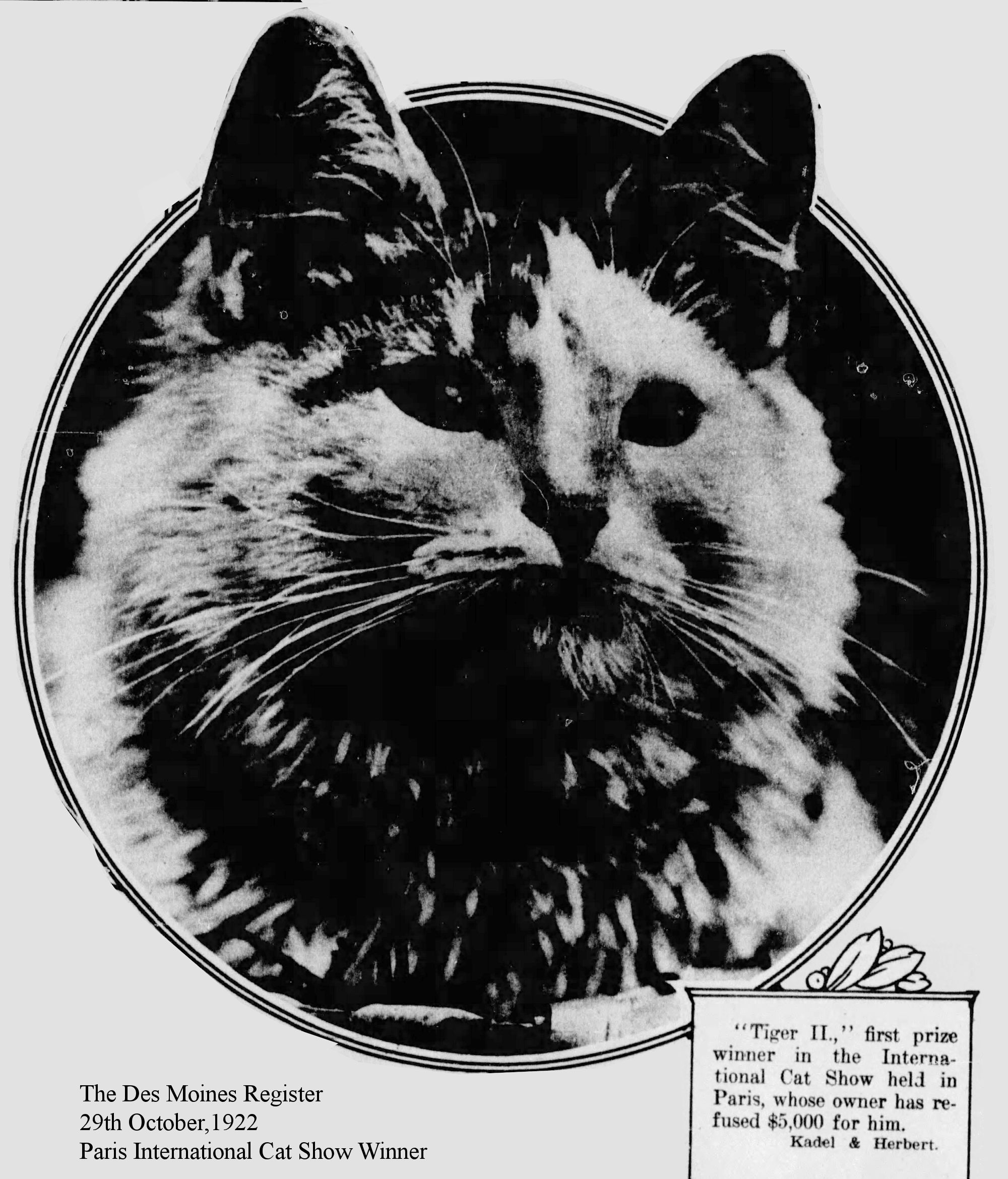
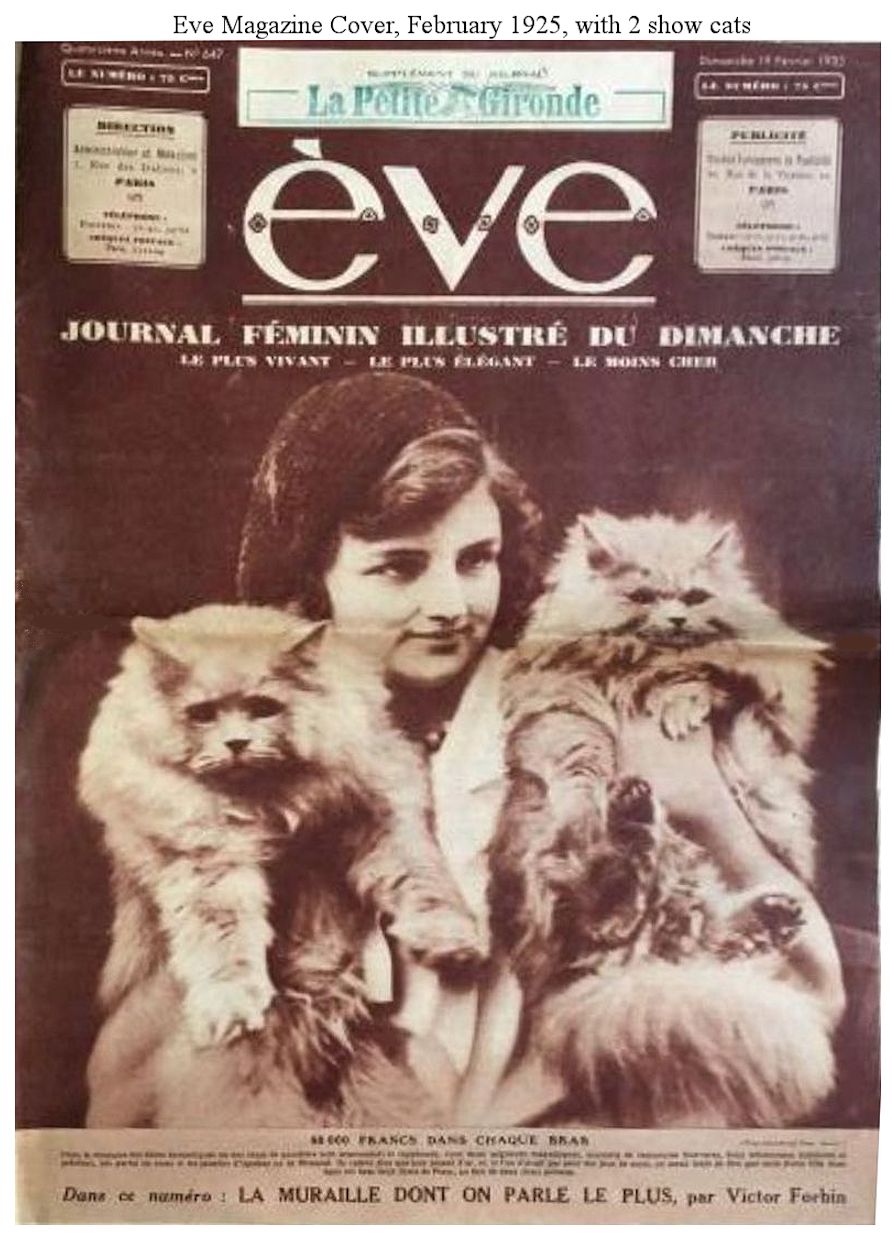
VALENCIENNES DOG AND CAT SHOW L'Eleveur (The Breeder), Combined with Hunting and Sports Magazine, Illustrated Weekly Newspaper of Animal husbandry, Acclimatization, Hunting, 1926
Valenciennes (June 6, 1926). - The annual exhibition of the Valenciennes Huberte Club brought together around 275 dogs, as in previous years [. . .] The Place Verte grounds are indeed the ideal location for open-air events; be careful, gentlemen members of the committee, for your next meetings, because if the rain had fallen like at 7 p.m. the exhibition would be over. Around ten cats were on display; none seemed to deserve a 1st prize and I believe that the judge, Ms. Brassart, should have retained these distinctions; this is very good and does not distort the education of amateurs.
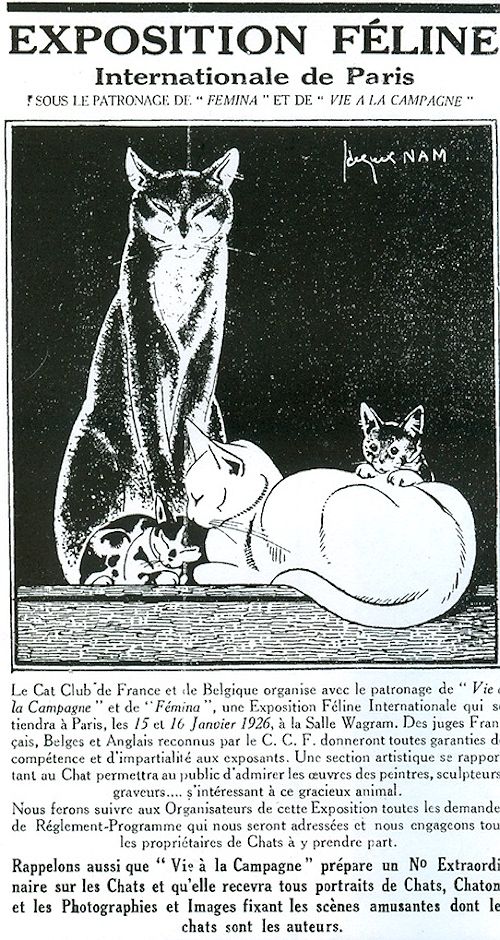
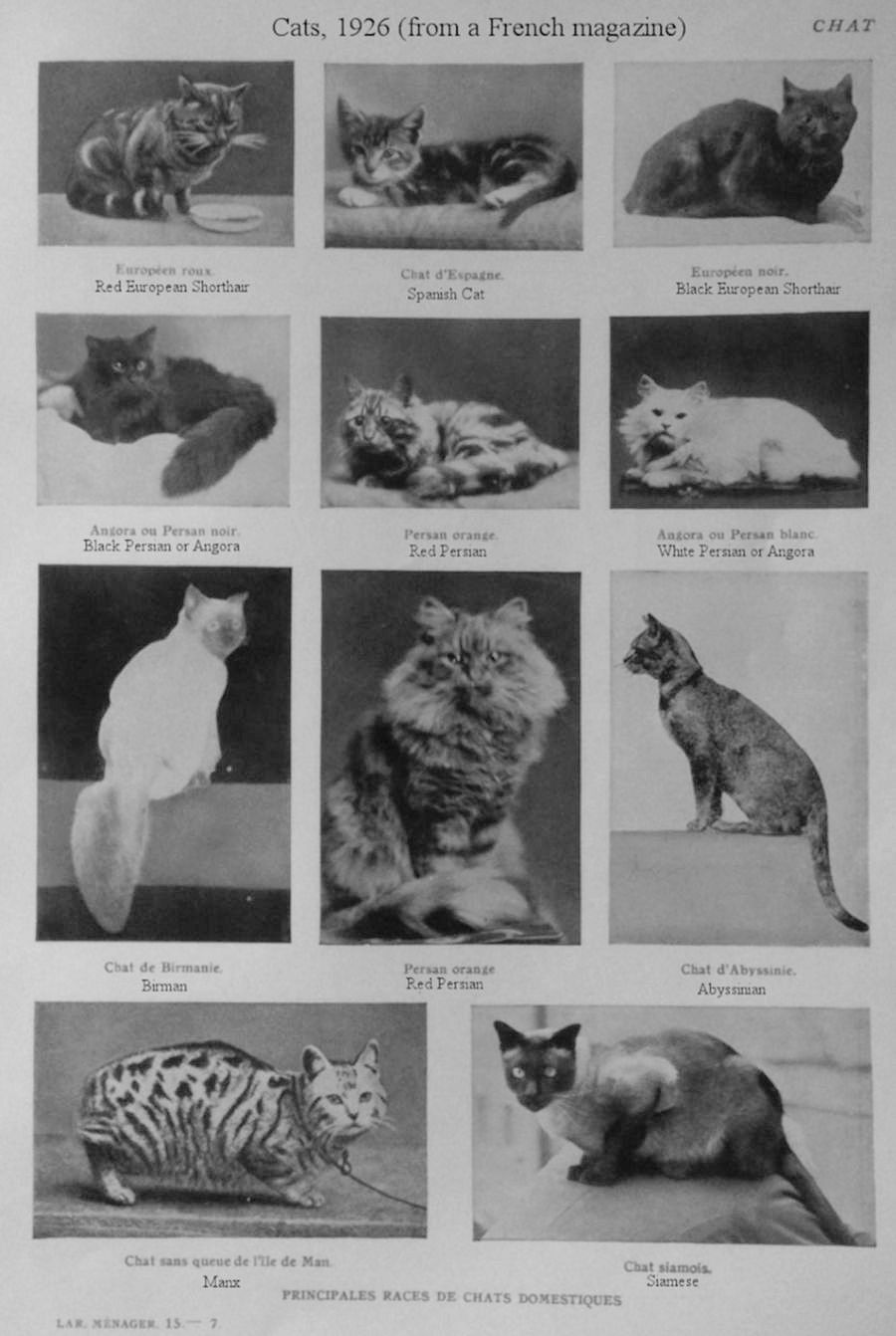
[FROM PARIS BY MADAME RAOUL NICOLE] Western Mail, 22nd May 1926
How different from [the dog show] was the show I went to the evening when all the aristocracy and beauty of the dog's natural enemy, the cat, were displayed to the vulgar eye in the enormous Salle Wagram. Of course, the descendant of a thousand Shahs, the blue Persian, was the cynosure of every eye, but some magnificent specimens of the Siamese cat were exhibited. Strangely enough, as in the more fancy breeds of the dogs, all the prizes in the classic races of the cat family were won by either English or American owners. I think that the difference in the mentality of the dog end the cat was well shown in the behaviour of the two animals in these shows. The dog relied on his master to release him from his ignominious position, while the cat seemed to expect all the admiration that was given him, and was only extremely bored with the whole proceedings.
ECHOES OF THE CAT SHOW [PARIS]The Gentlewoman, 5th June 1926
ECHOES OF THE CAT SHOW. Lack of space prevented me last week from referring to the Cat Show, to which so many English people were attracted, at the Salle Wagram. Lovers of animals seemed as much interested in the superb Burmese, Siamese, and Persian species on view as they appeared unanimous in deploring the manner in which these pets were exhibited. Excessive heat - due to an intense crowd - alternating with icy draughts affected the animals. Besides, they were huddled together, lacking space to move, air to breathe. Some cats were so nervous and tired as to display convulsive eyes. But, as this exhibition was a genuine success, it is to be hoped that next year the organisers will remember these discomforts and show more consideration for the welfare of these precious animals.
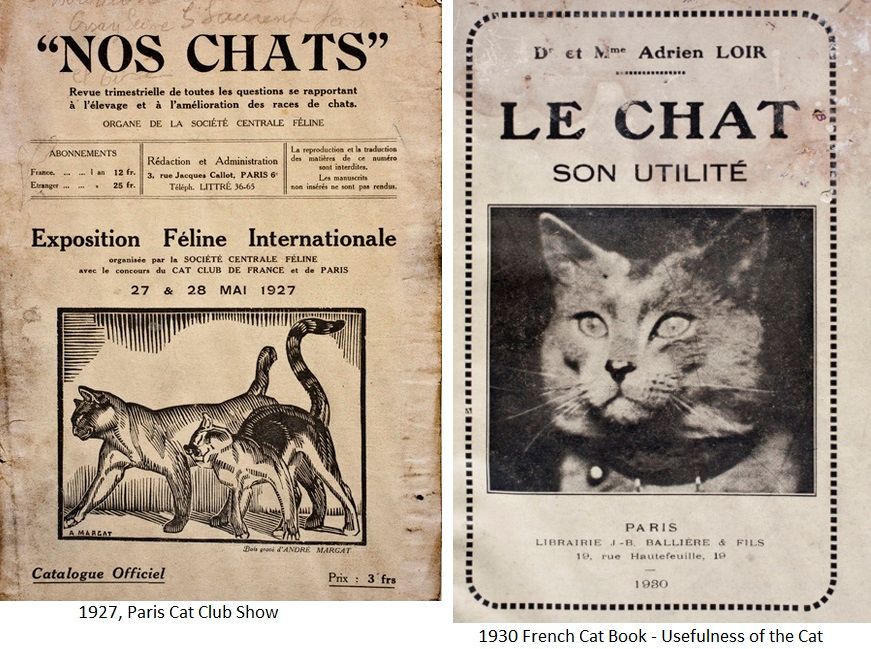

DOLL PET FOR PERSIAN CAT Derby Daily Telegraph, 9th February 1929
Two hundred pampered Persian cats, from all over the world, were displayed at the International Cat Show, held at the Salle Wagram, yesterday. Most of the animals had splendid homes of their own, with carpets, silk cushions, and electric light. One had a doll of its own, and another was provided with a home decorated with mimosa, and bearing a picture of its owner.
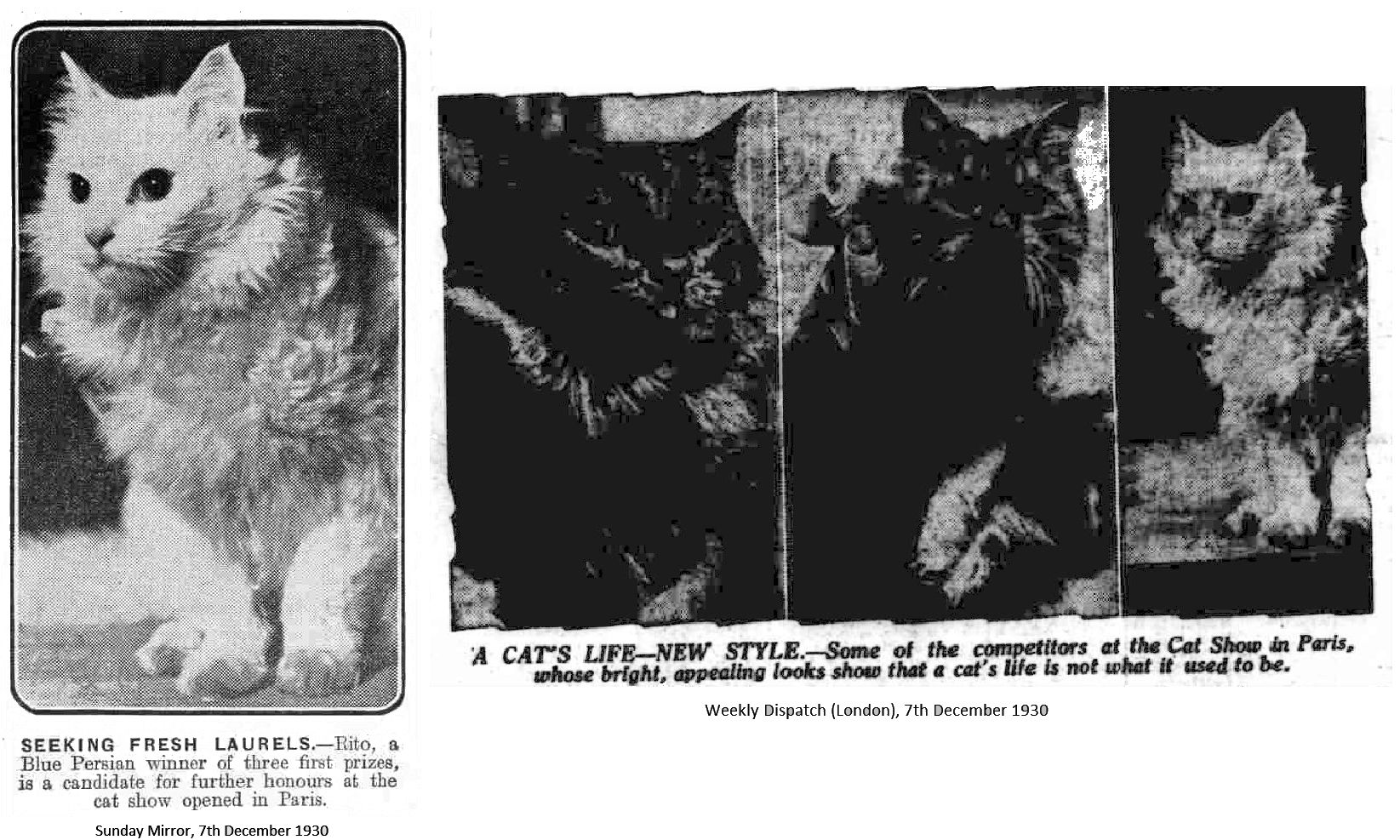
HIS HAIRLESS HIGHNESS - SOVEREIGN RULER OF A SHOW Daily Herald, 28th April 1930
PARIS, Sunday. The only naturally hairless cat in the world, unashamed of its sombre nakedness, has assumed unquestioned sovereignty of the great cat show being held in Paris. Even an aristocratic troop of rose-tinted mousers from Turkey dare not question its lordship. As for seven Abyssinian cats, whose barbarous extraction is scarcely disguised by their education the most select of Austrian cat seminaries, they are completely abashed by His Hairless Highness. The proudest two of Burma's sacred cats, secure in spiritual inviolability, frown on this elevation of the flesh - "and such ostentatiously bald flesh," one was heard to purr. A primitive cat from the Congo mewed plaintively for a witch-doctor come and exorcize the demon in their midst, while several furtive friends from Afghanistan tried to convince him that if the almighty Hairless One could only be persuaded visit them at home, he could easily be ambushed in the mountains round Kabul.
CAT SHOW IN THE SALLE WAGRAM, PARIS - The Brooklyn Daily Eagle (New York) 8th May, 1930
Paris, May 1 - What is thought to be the only naturally hairless cat alive, completely disgusted at the attention given to his nakedness, drowses boredly, the focus of all eyes at the cat show in the Salle Wagram. A wretched bundle of bones in a thin wrinkled bag of mottled skin, he demonstrates that, whether or not clothes make the man, it is beyond a doubt hair that makes the cat.
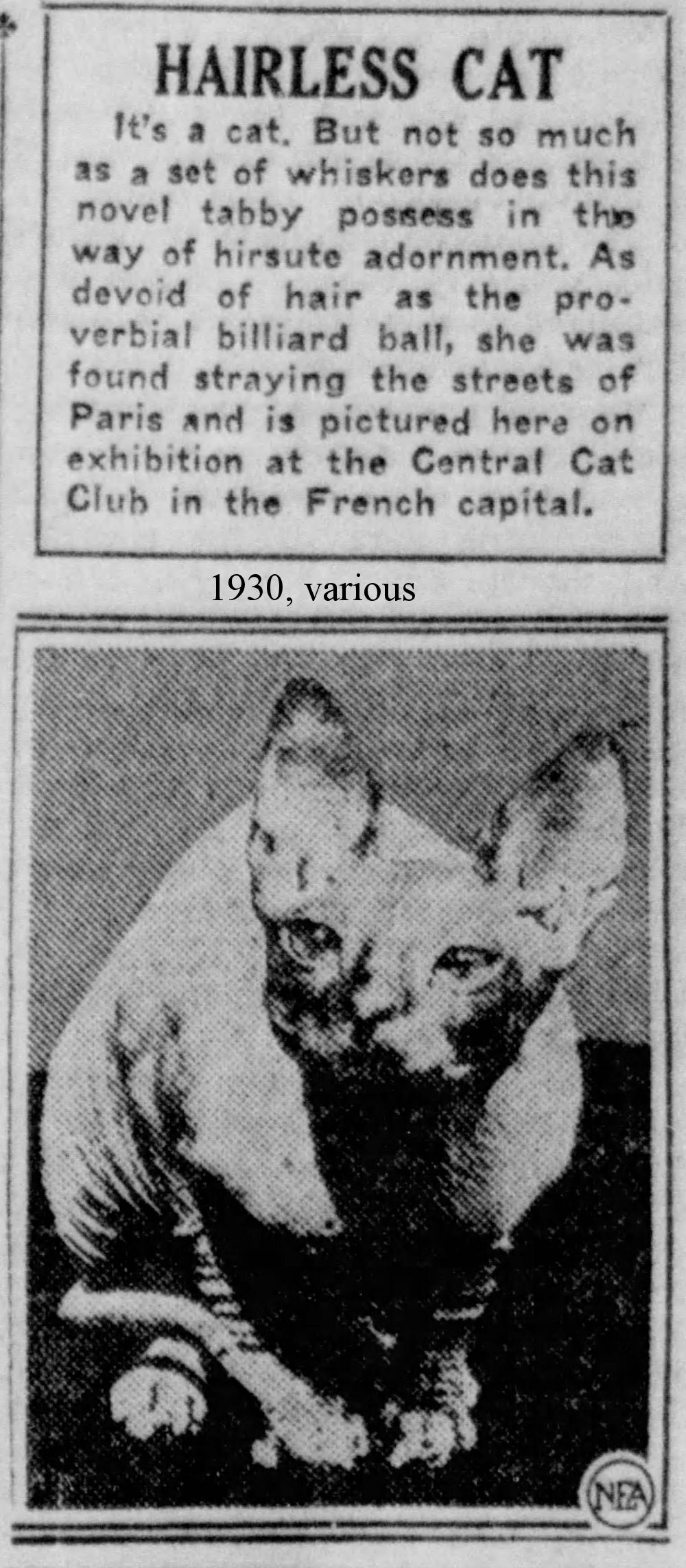
The complicated geographical divisions on this side of the water have few advantages, and one of them is the increased interest they give to a cat exhibition. The "rose mousers" from Turkey would be much less exciting if they were merely from one of the United States of Europe. The seven Abyssinian cats, which incidentally come from Vienna, are infinitely more attractive as from Austria; a definite nation, than if they merely came from a European Chicago.
Sacred cats from Burma there are among the others. They are innocent enough looking, these Burmese pussies. Nobody would suspect from looking at them that each is a Burmese monk reincarnated, at least so the Burmese say. Only a hundred of them are supposed to be alive, 98 In a Burmese monastery, where each awaits the death of his master, ready to receive his soul.
Another ordinary-looking cat is the cat of the Chevreuse, doomed to extinction, the cat experts say, because there remains no Chevreuse Tommy to father the next generation. A Brazilian kitten exhibited with the house cats turned out to be nothing less than a baby Brazilian jaguar.
The long-haired cats were neglected this year. Cage after cage of lazy Persians and Angoras yawned through the wire netting into empty space. Nobody had time to waste on them. Aside from his royal nakedness, the hairless cat, the black-eared and black-footed Siameses, with blue eyes and bass voices, ran away with the exhibition. All day long Parisians clambered past them three and four deep, exclaiming admiration. The Siamese has swept the country like an epidemic in the last few years. They are half savage, and yowl more dismally than any alley cat. But they are extremely decorative. They leap like kangaroos. And their short, stiff bristles are exceeding inhospitable to fleas.
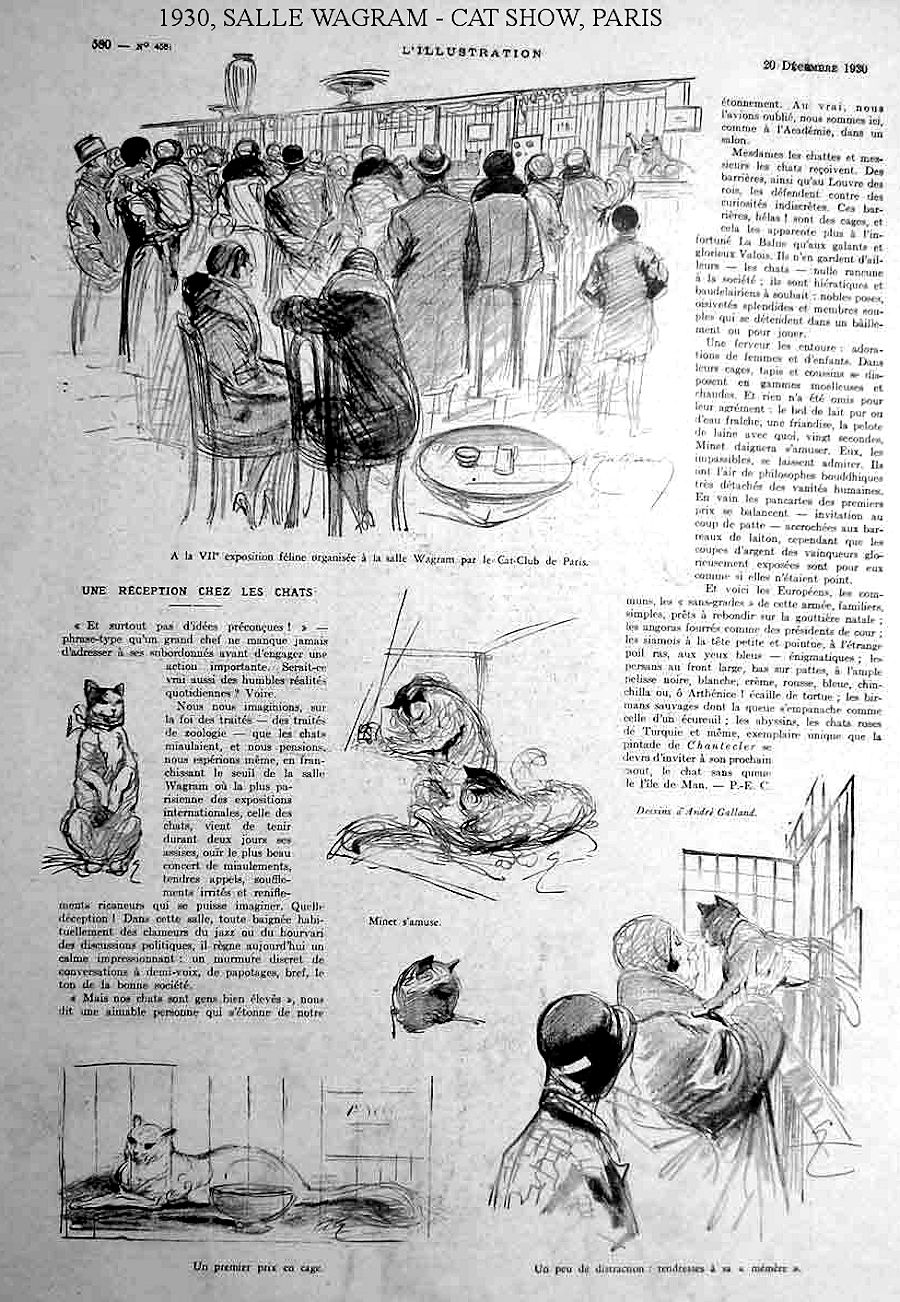
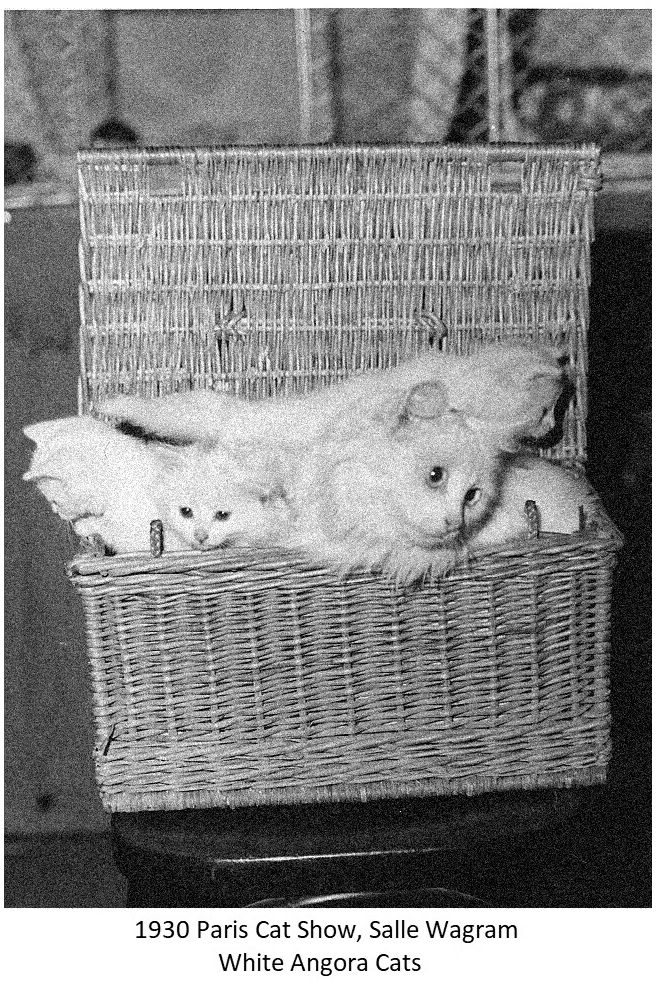
FIFTH DAY OF THE TRADE FAIR
With the return of the good weather, many visitors attended: 13,000 admissions were recorded.
L'Ouest-Eclair 30th April, 1931
Thirteen thousand people visited the Trade Fair yesterday; this figure is increased by a thousand compared to the corresponding day last year. Finally, we had good weather and the sun even dared to shine at times. The crowd lingered longer in front of the stands. The exhibitors who, in recent days, had grumbled about the inclement weather, regained their spirit yesterday and used all their qualities as salesmen. But there is no need for a lot of blarney when the goods are good. There is no junk at the fair. Everything on show interests everyone to varying degrees. The buyers were quickly convinced of the good quality of the products and did not fail to buy them. Agricultural and other industrial machinery was even more successful than the previous day and orders poured in. There are interesting creations in this section. Be sure to take a look. You will return delighted.
The cat show
The Cat Show was inaugurated yesterday morning at 10 am by Doctor Ph. Jumaud, President of the Cat Club of France, who was a judge on this occasion. In fact, there was not a large number of animals on show. However, though they were few in number, they were of good quality. Why weren't there more people exhibiting their animals? Doctor Ph Jumaud gave this explanation:
"It is the first time that the Rennes Trade Fair has organized a cat show. There are certainly some people from Rennes who own cats that can compete with those you have seen today. I heard a lady say, "Oh! mine is more beautiful than that! But then, she did not realise; she did not imagine that her cat had a chance of winning. This is why she, and many like her, did not enter the show. Next year, the situation will be different. An example has now been set. You will see that exhibitors will be much more numerous."
Despite everything, we had the opportunity to admire very beautiful specimens: blue Persians. Cream, Siamese, black, white and grey Europeans, Angoras, Chartreux, etc. Competition was close and the placings were difficult. Doctor Jumaud, judge, established the placings as follows:
BLUE PERSIAN - Championship class - 1st prize Colnside Carol, Mme Pereyrol
Male - Open class - 1st prize, H. B. Donald, Mrs. Castex.
Female - Open class - 3rd prize, Ninette, Miss Catheline: 2nd prize, Noune, Miss Leger.
Neuters - 1st prize, Pipeto, Mme Maubec.
CREAM PERSIAN (male championship class) - 1st prize, H. B. Reve, Mrs. Pereyrol.
Female - Open class - 1st prize, H. B. Opale, Miss Leger.
SIAMESE. - Young males class. - Mention, Thi-Tou, Mme Mrs. Lasne.
Male Limit class. - 1st price, Siam, Mr. Thomson; 2nd prize, Charlot, Mme Michec; 3rd prize, Mistiti, Miss Bodet.
Female Limit class. 3rd prize, Mimi, Mr. Thomson; 3rd prize, Mistata, Miss Bodet; Mention: Thy Mao Youlette, Miss Morault.
Female Open class. - 1st prize, Kitta, Mme Michee.
Breeders class. - 1st prize, Co-Mi, Miss Dervien ; 2nd prize, Pouba, Mme Pierre Brault; 3rd prize, Thy-Souk, Mme Beaufils; 3rd prize, Thy-Sam, Mme Bodet.
BLACK EUROPEANS. - 2nd prize, Fanora, Miss Esnaud.
WHITE EUROPEANS. - 1st prize, Bec-Rose, Mr. Rene Noury.
GREY EUROPEANS. - 2nd prize (C. L), Loulou, Mr. Minden,
IRREGULAR EUROPEANS. - 2nd prize, Pousset, Mme Fauvel; 3rd, Friquette, Mr. Follope.
IRREGULAR ANGORAS. -2nd prize (C. L.), Zita, Mr. Quoniam; 2nd prize (C L.), Poussette, Mrr Yanik Gorret.
CHARTREUX. Female Open class. - 1st prize (C. A. C.). Mignonne de Guerveur, Miss Leger; 2nd prize Blue Bird price of Guerveur, Miss Leger
Young females class. - 1st prize, Espisgle de Guerveur, Miss Leger.
Open Male class. - 2nd prize, Dolcis de Guerveur, Miss Leger.
Group Class. - 1 prize, Dolcis, Esplegle, Mignonne, Blue-Bird, Miss Leger.
Neuters. - 2nd prizes, Fifi, Mme Merand.
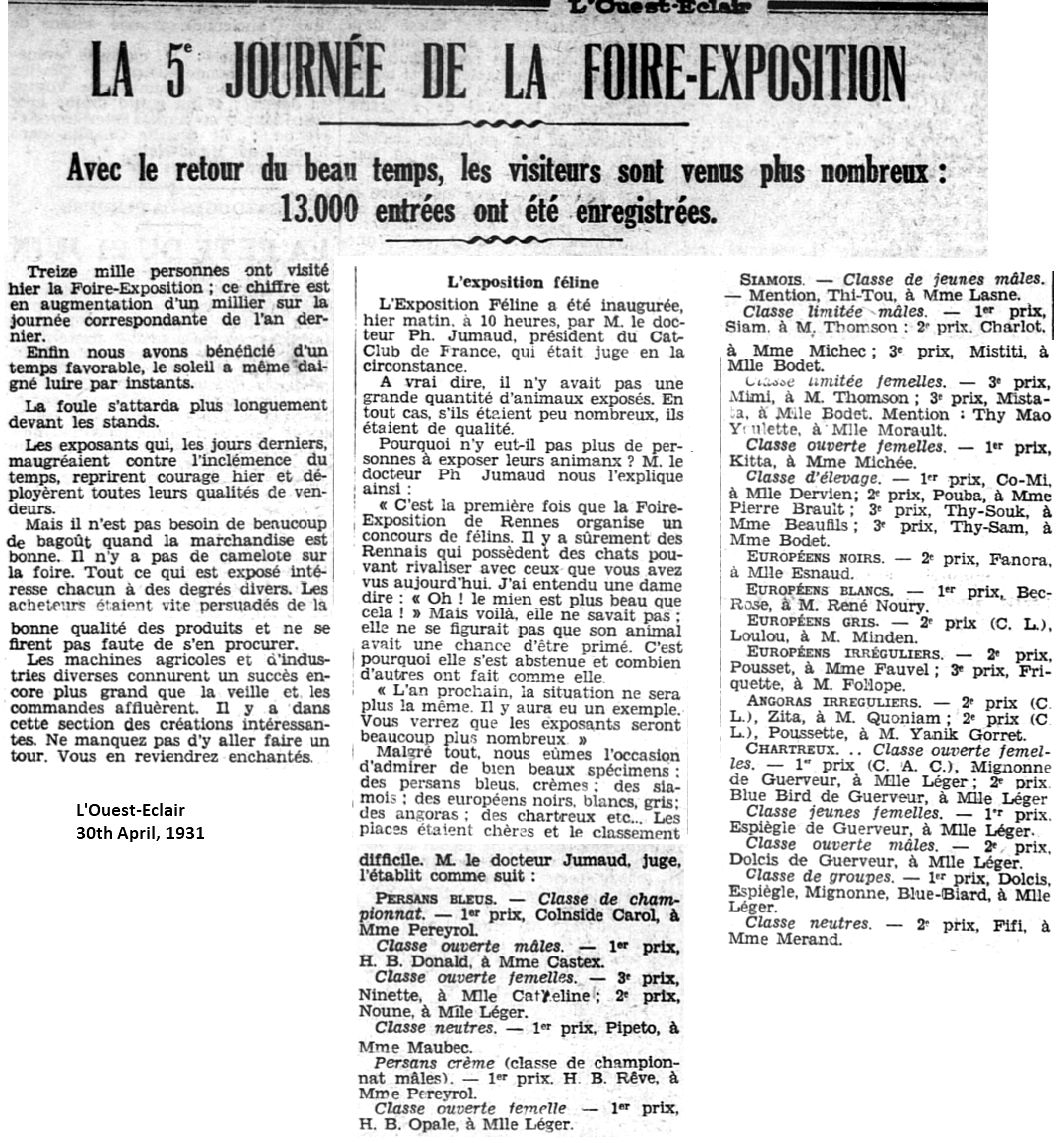
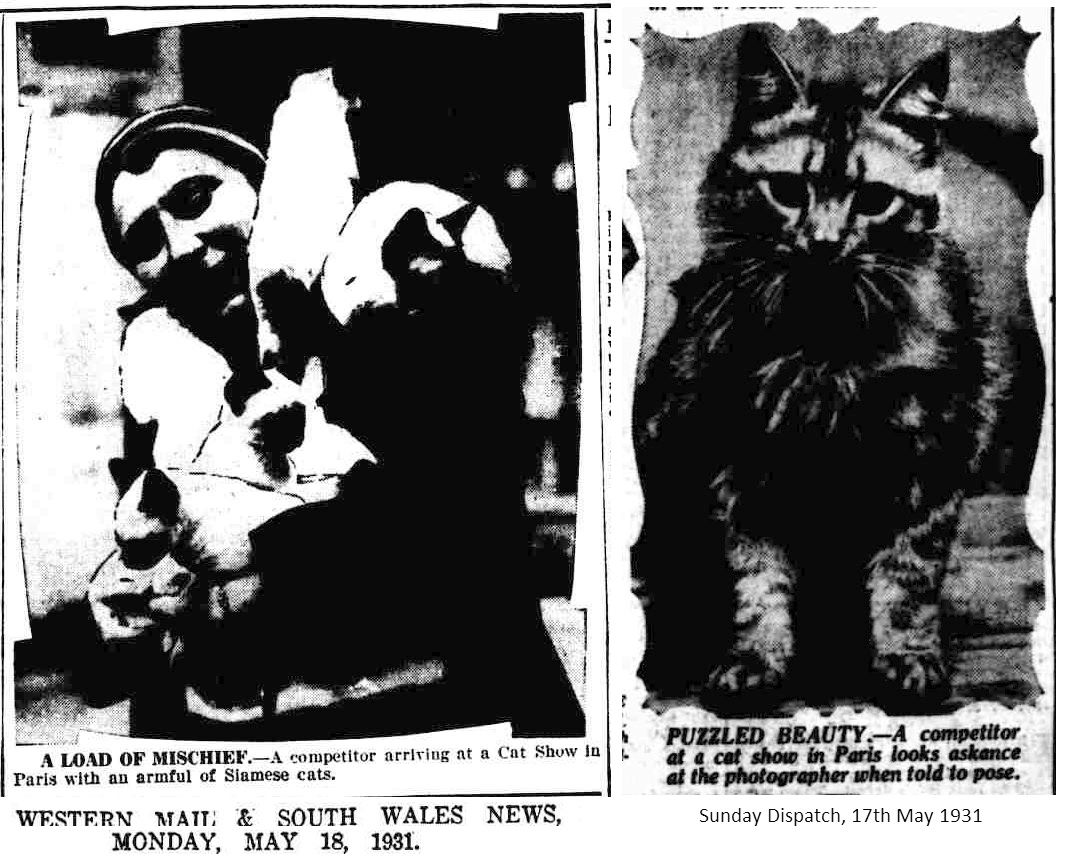
[PARIS CAT SHOW] Yorkshire Post, 11th April 1932
The winds are wild about Paris this month, and all the brave efforts of the Parisians to start their spring season in the hope of drawing to the city pleasure seekers are made difficult . . rain and winds . . . The cat show, so much frequented by men and women of letters and society women who find in the indifference of a cat all the charm which the friendly simplicity of a dog does not offer, has fared no better. Rare cats from the East were exhibited; Brazil, Abyssinia, Persia, Siam, provided specimens of great beauty and distinction. As a contrast to these aristocrats, there was team of rat-catching cats belonging to a big firm of manufacturers. Cats, it is claimed, are better rat-catchers than dogs.

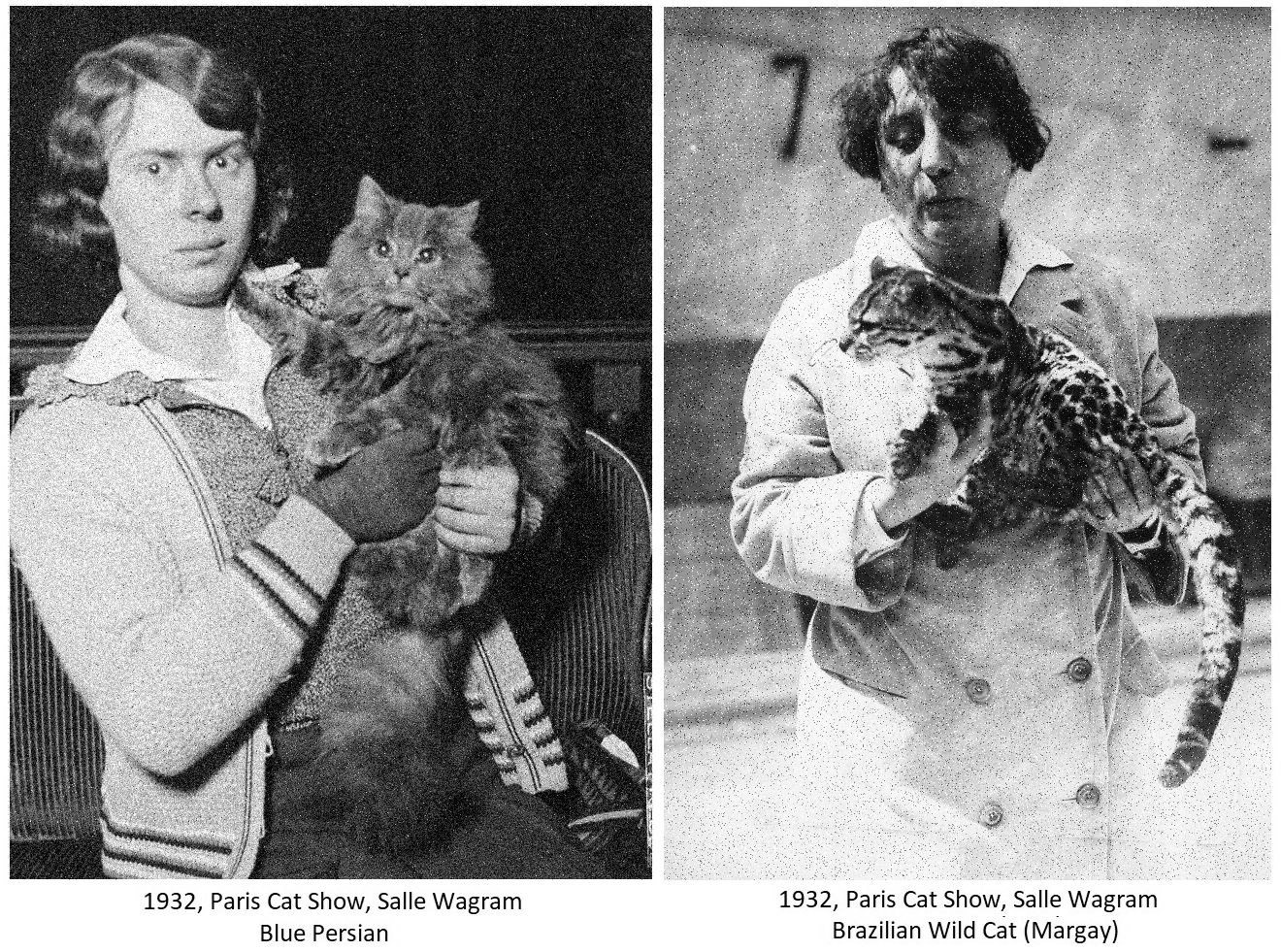
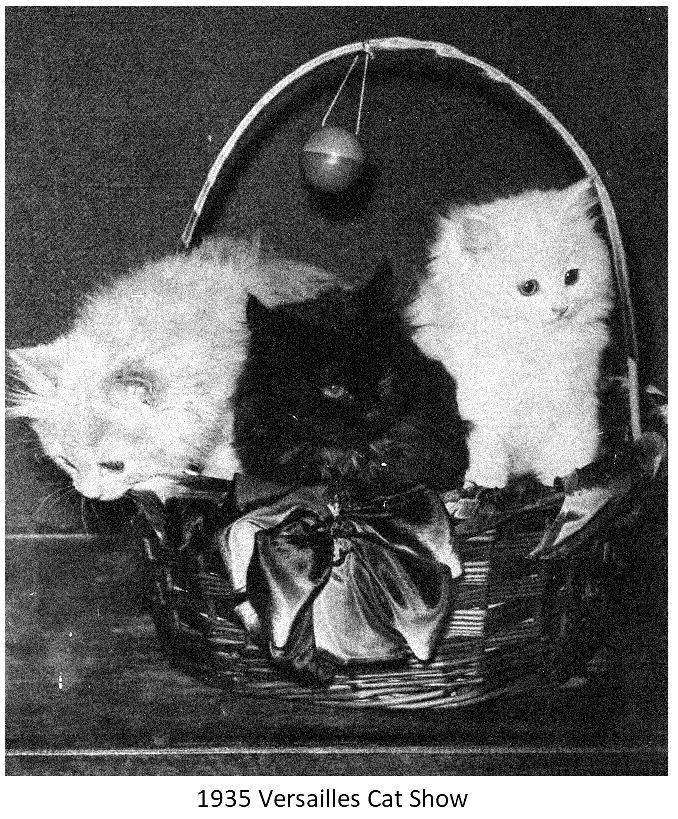
RIVIERA CATS Daily Mirror, 25th February 1936
Lady Collins, whose husband, Sir Godfrey, is the Secretary for Scotland, went to the [French?] Riviera for a holiday and as a consequence is now the president of a Cat Club. The club was formed by a friend, who insisted that Lady Collins should be its leader. The holiday for Lady Collins has been a perfect orgy of cat-inspecting. The club's purpose was to get together an exhibition of pedigree cats, and these had to be "seeded" from among the scores of people who have been writing to ask if less aristocratic little "Tibbies" couldn't join. Finally, Lady Collins and Miss Strang Steel, the cat expert, gave a Cat Cocktail party, at which a number of prize cats preened themselves for the entertainment of the guests.
[CAT SHOW, NICE] Daily Mirror, 15th April 1936
A cat may look at a king, but it ought to stop short at scratching him on the hand. A proud blue Persian was being shown last week at the first cat show ever held in Nice [French Riviera], organised by the Hon. Mrs. Reginald Brougham. Among the visitors was a tall, cheerful-looking man, who walked round stroking the exhibits. The Persian, which was in a bit of a huff anyway, flashed out a paw and dug its claws into the hand. At once there was a tremendous to-do because, of course, as you rightly guessed, the tall man was King Alfonso. But he took it well and passed on to other exhibits.
The cat, which has been in disgrace over Easter, had some excuse because it hadn't won a single prize in its class. Furthermore, it had been placed next to the cat belonging to Mlle. Flandin, daughter of the French Foreign Minister, which was purring in a perfectly maddening way after winning a superb liqueur service.
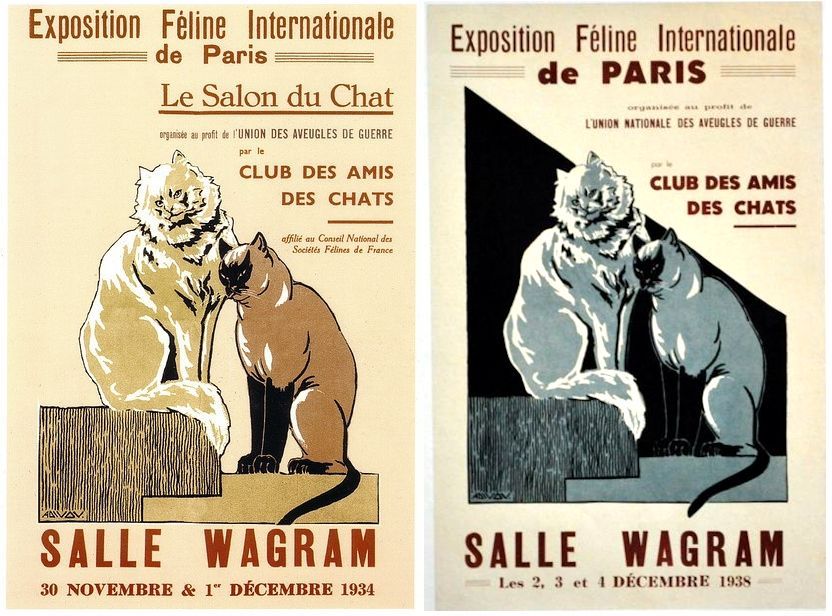
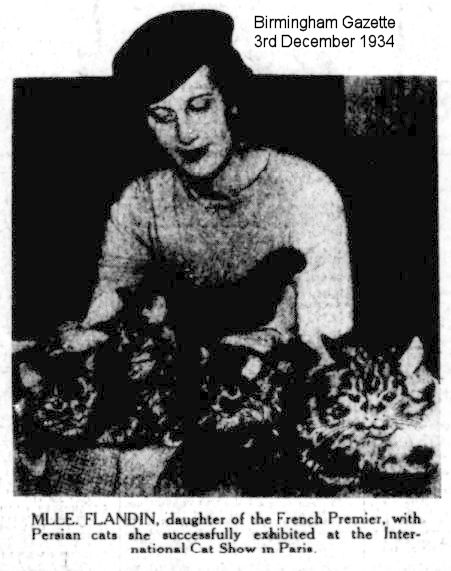
TOPICS IN FRENCH CAPITAL - CAT SHOW CREATES INTEREST - The Sydney Morning Herald, 4th March, 1937
(From a Correspondent)
PARIS, Feb. 12.
The Cat Show in the Salle Wagram is a highly social event. It also means a flood of ink being spread over the daily newspapers from the pens of the intellectual. Well-dressed men and women stand in admiration before the luxurious cages in which are imprisoned the beautiful and inscrutable animals, some of which arrived by air from London.
What is it in cats which compels intellectuals to bow down before them has never been clearly explained, but Mr. Paul Morand has written this week an article in the "Figaro" which leaves no doubt about the fact. From the days of the Greek philosophers up to our present times, when, Mme. Colette leading, writers of distinction accept the cat as a creature to be admitted to their most sacred silences, Mr. Morand quotes name after name from a long line of distinguished men and women in letters as being cat-lovers, or rather cat worshippers. To them may well be added many an inglorious Milton; old ladies whose life is bound up in a sleepy overfed tabby, surly old men who snap at their wives and caress their smug tortoiseshell. Finally, Mr. Morand, like the rest of men, points to the affinity of cats and women. Both are riddles to which man has not yet found the answer.
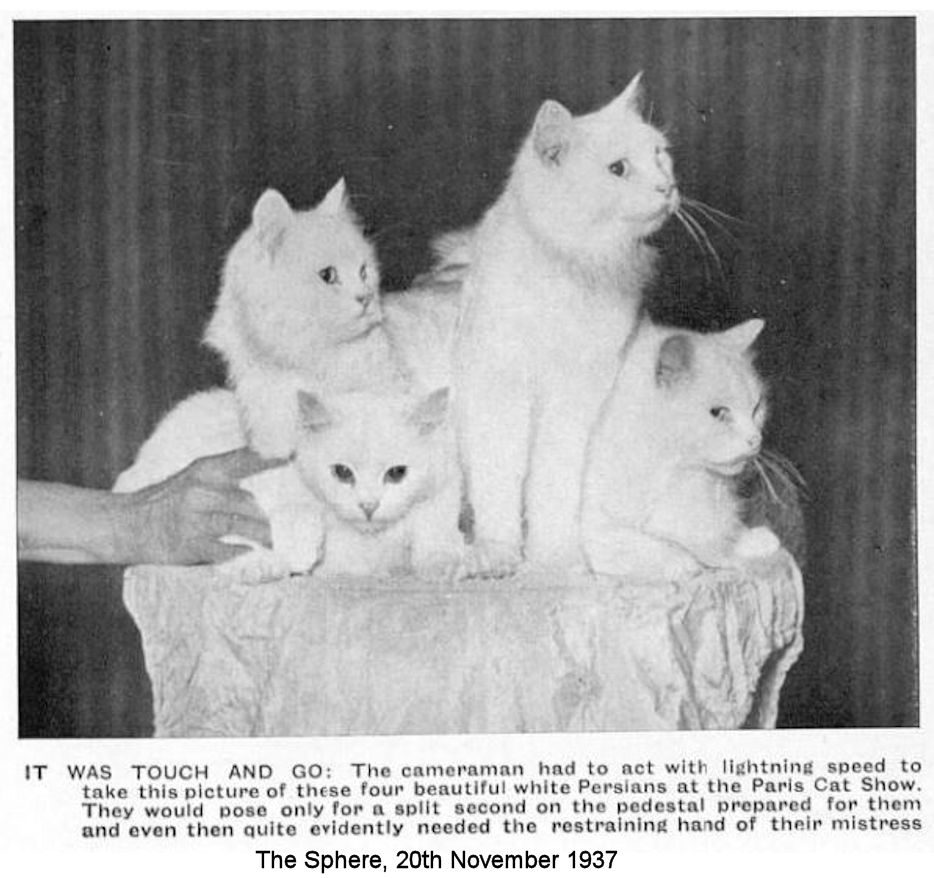
1938 PARIS CAT SHOW, SALLE WAGRAM
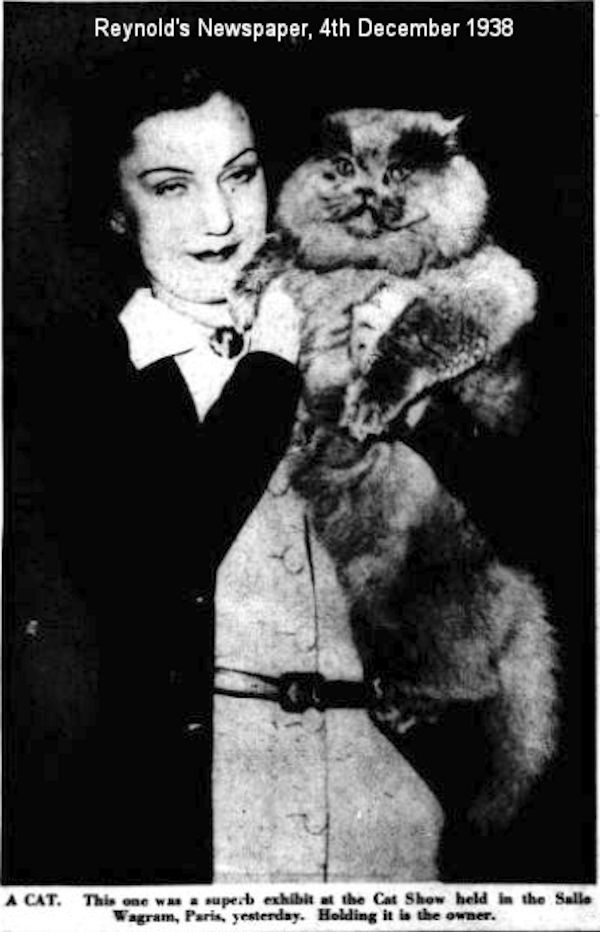
PRISCILLA IN PARIS (COLUMN) The Tatler, 1st February 1939
[. . . Maurice Magre, first secretary at the Elysee, started to explain why President Lebrun's very beautiful Burmese pussy was not present at the Wagram cat show [. . .]
[PARIS CAT SHOW] Lancashire Evening Post, 2nd April 1947
Hundreds of cats from Britain, America, Switzerland and France will be judged at the Cat Club of Paris show this month.
[PARIS SHOW] ABOUT THE BLUES Fur and Feather, Rabbits and Rabbit Keeping, April 11, 1947,
The Cat Club de Paris will stage a show on April 12th and 13th at which Miss Langston and Miss Yorke will judge all the long hair cats. Judging will commence on Saturday afternoon. My thoughts will be in Paris on this occasion as the last time Miss Langston judged there, in January, 1938, I stewarded for her, and it was a very enjoyable experience.
Opinions differ as to whether cats should be exhibited in decorated pens, but I was enchanted with my first introduction to a Parisian Cat show. It was held m a lovely ballroom near the Arc de Triomphe, and I admired the gleaming silvery pens, which were all a uniform size, square and roomy, with large doors, which gave one ample room to remove the exhibits. The interior of every pen had hangings of lovely materials, mostly in white, provided by the exhibitor. Some pens had white velvet or satin, and one had silver spangled chiffon over white satin, with cushions to match. Chinchillas reposed on these and the effect was lovely. Several pens were outlined with real flowers, such as camellias, lily of the valley, and stephanotis. I remember vividly the late Madam Guyot's long-haired reds in their pens, which were hung with green velvet and outlined with marigolds. The contrast was most effective.
The method of judging is different in France and the judges stood on a rostrum in the centre of the ballroom and, as each owner was allowed to pen all his cats together, irrespective of the variety, we stewards were kept busy carrying cats over the polished parquet floors.
After the first day a gala dinner was arranged for prominent members of the French Cat Fancy and the British visitors. The atmosphere from first to last was that of a super cat show plus a social event, and it certainly put ideas into one's head. The shows of the Cat Club de Paris are organised on behalf of charity, so there is no prize money.
Miss Langston as judge, and myself, were graciously treated, and I remember vividly walking into my hotel bedroom to find a basket of lovely red roses tied with tricolour ribbon and a graceful little note of welcome. The best exhibit in the show was Madam Guyot's Townfield Monarch, a very lovely Blue male bred by Mr. Bolton, and there were a number of excellent British bred Chinchillas and the exquisite Cream male, Mint of Hanley bred by Mrs. Stevenson.
[1947] THE PARIS SHOW Fur and Feather, Rabbits and Rabbit Keeping, May 2, 1947.
I was delighted and surprised at the general high quality of the cats I judged at the Cat Club de Paris's first show since the war. French fanciers went through a very much worse time than British fanciers, before and during the German occupation. Food was practicably unobtainable and the few pedigree cats that did survive were hidden. Therefore, it is all the more remarkable that there were so many exhibits and that many were of such high quality.
Mrs. Gibbons has been living in Switzerland during the war and has kept her fine cattery intact. She and her ten beautiful cats flew to the show, and were, indeed, an exhibi-tion in themselves. I have never seen such a class of lovely Chinchilla females, and I would have loved to smuggle some of them over here!
The best cat in the show was Mme. Gibbons's home-bred Farquhar Tatiana, a striking example of what a Chinchilla should be, Tatiana has a beautiful head, purest, very sparkling colour and huge round eyes of emerald green. The best male in show was Mme. Gibbons's Ch. Wotan, the beautiful English-bred golden eyed white. He is now an international champion as he has won challenge certificates in England, Switzerland and France. There was a fine cream, Nadis du Ponthien, bred by the late Mme. Guyot, and two very promising cream kittens, children of Ch, Widdington Warden and bred by Mrs. Shepherd. Both blue-eyed and golden-eyed whites were of the highest quality, the blue-eyed whites being superior in type to the present-day English cats, though I think our English cats have better eye colour.
The best kitten in show was a wonderful blue Chinchilla owned by the Barorne de Vanfrelant. Alle de Nyanina is an absolute picture, with glorious head, huge round eyes and profuse coat of a pearly lavender shade. The blacks and torties were nice but not as good as the others I judged.
Mme. Ravel is to be congratulated on the manner in which she ran this admirable show, and I must thank her and many other fanciers for the wonderful welcome given to Miss Yorke. The Paris show of April 1947, will always remain in my memory as one of the happiest times I have ever spent. - Evelyn Langston.
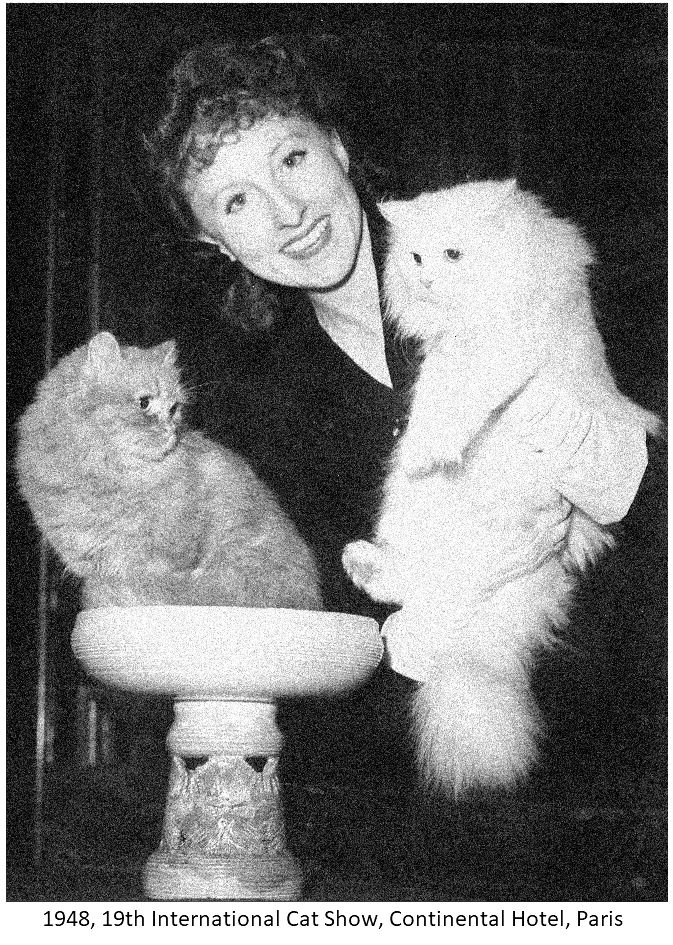
[PARIS INTERNATIONAL CAT EXHIBITION] FELIX KEEPS ON SAILING Sunday Sun (Newcastle), 1st February 1948
Every time the Queen Mary sails for America she takes about 15 expensive dollar-earning British cats to new homes in the United States. Mrs Gertrude Bridgette, president of the at Club of Paris, imparted this information to Reuter at the opening of the International Cat Exhibition in Paris. "English cats are the most famous in the world," she said. "They are particularly sought by Americans, who are buying as many as they can." Mrs. Brigette, an American, has a Persian blue claimed to be worth at least £500.
[PARIS CAT CLUB SHOW] West Sussex County Times, 19th November 1948
Mrs. M. Brunton, of Marlpost Farm, Southwater, made her first flight recently when she went to Paris to judge at the 19th Show of the Cat Club of Paris. She left Northolt for Le Bourget on November 9 and returned to London Airport on Saturday. About 150 cats were exhibited and the show was in aid of tuberculosis prevention. It was Mrs. Brunton's first appearance as a judge and she handled about 50 of the cats. Before the war, when she lived in Maplehurst she went Blue Persians abroad to foreign buyers who wished to improve the strain of their own breed. She has not exported any since the end of the war.
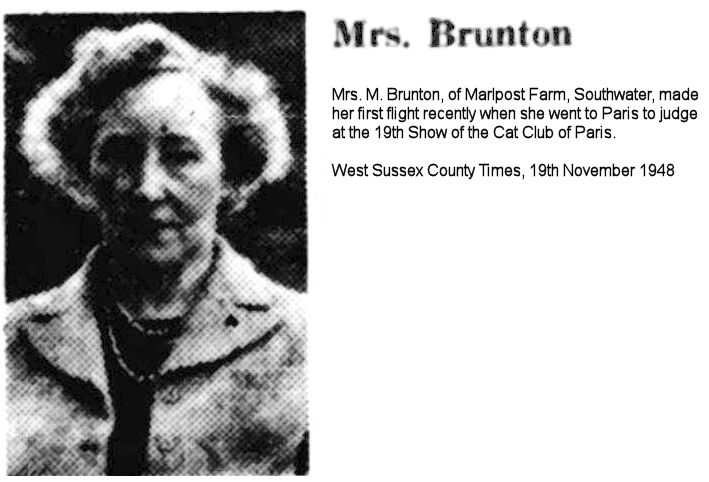
Best cat and best kitten in the Paris show were both of English origin. In 20 years of breeding cats Mrs. Brunton has won several hundred prizes. Her Blue Persians-she at present has four - have complete freedom to roam where they will as she believes a cat in those conditions is healthier. The most interesting exhibit at the show was an ocelot cat from South America. which although quite wild in its natural state had been brought up and tamed from a kitten. "The owner handled it. but no one else could be persuaded to touch it." commented Mrs. Brunton.
[PARIS CAT SHOW] 21ST INTERNATIONAL CAT SHOW various, 28th/29th October 1949
Paris, Friday.-Three hundred prize cats from all over Europe are to compete for the title of "most beautiful cat in the world for 1949," at the 21st International Cat Show to open here November 4.
[PARIS CAT SHOW] PRETTIEST PUSS various, 5th November 1949
Almond-eyed Southway Nicholas, British-born blue Persian cat, was to-day declared the most beautiful cat in the world for the third year in succession at the International Cat Show, organized here by the Paris Cat Club. Mayor Pierre de Gaulle presented the trophy to Nicholas' English owner, Mrs. Leila Gibbons, owner of the Farquhar cattery in Lausanne -Reuter
[PARIS CAT SHOW] WORLD'S LOVELIEST CAT CAME FROM LINCOLNSHIRE Stamford Mercury, 11th November 1949, Spalding Guardian, 25th November 1949
For the third successive year Lincolnshire-born Southway Nicholas, an almond-eyed Blue Persian cat, which was bred by Mr. J. H. A. Martin, Southways, Helpringham, and is now the property of Mrs. Leila Gibbons, Philadelphia, was declared the most beautiful cat in the world at the 21st annual international show of the Paris Cat Club at the weekend. Mr. Martin, who was one of three who went from England to judge the cat show, specialises in Blue Persians and has many feline friends. A brother of Southway Nicholas is the international champion Southway Wizard, which is also abroad, and another champion is Southway Crusader. The mother of all three is Southway Whiz, owned by Mr. Martin.
THE MOST BEAUTFUL CAT IN THE WORLD The Scotsman, 5th November 1949
Paris Contest in Luxury Hotel Paris, Friday. -Three hundred and twelve cats from seven nations are competing for the title of the most beautiful cat in the world at the 21st International Cat Exhibition which opened here to-day. The all-British three-member panel of Judges comprises Miss Kathleen Yorke, Miss Kit Wilson, and Mr J. H. A. Martin. The three-day show is being held in a suite of oak-panelled, crimson-carpeted private banqueting rooms of a Paris luxury hotel. Overhead, massive gilt and crystal chandeliers were ablaze with light. Caged and cushioned on everything from bits of woollen blanket to six-inch deep white silk cushions, most of the cats slept as their owners fussed over them. One blue-cream Persian watched over by its owner was asleep in a silk-lined replica of a baby's cradle trimmed -with white tulle, while two French entries were supplied with rubber hot water bottles wrapped in soft woollen scarves. France, with 287 cats, has the largest national entry. Other countries competing are Holland, Switzerland, Italy, Denmark, Sweden, France, and the U.S.

[PARIS CAT SHOW] CAT STARS Liverpool Echo, 17th May 1950
The annual Paris Cat Show, the 22nd of the series, is being held this week-end in the Continental. The star turn will be the presentation, for the first time at a cat show, of a tame tiger. The annual cat shows, which usually muster some hundreds of the most splendid specimens of the feline race, always develop into a big Society event, though the visitors also include thousands of humbler friends of the domestic cat.
[PARIS CAT SHOW] Kirriemuir Free Press and Angus Advertiser, 2nd November 1950
A British-owned Chinchilla cat, Farquhar Aiglon, won the title of "The most beautiful cat in the world" at the 23rd International Cat Show in Paris.
[INTERNATIONAL SHOW, PARIS] Portsmouth Evening News, 23rd May 1951
In our correspondence columns recently there was a lively debate on whether cats were good companions or a social menace. The members of the Southsea Cat Club did not join in, yet they are probably the best people to judge. There are in the whole of England only 12 recognized judges of the finer points the feline form, and two of the most notable belong to the Southsea Club. They are Mrs. A Cook-Radmore, Chairman of the Club, and Mrs. E. G. Aitken (Assistant Secretary) and they have the distinction of being the only English judges to invited to officiate at this year's international show organized by the Paris Cat Club. Both the Chairman and Mrs. Aitken have judged at Olympia, and Mrs. Cook-Radmore has also officiated at Redhill and Felixstowe.
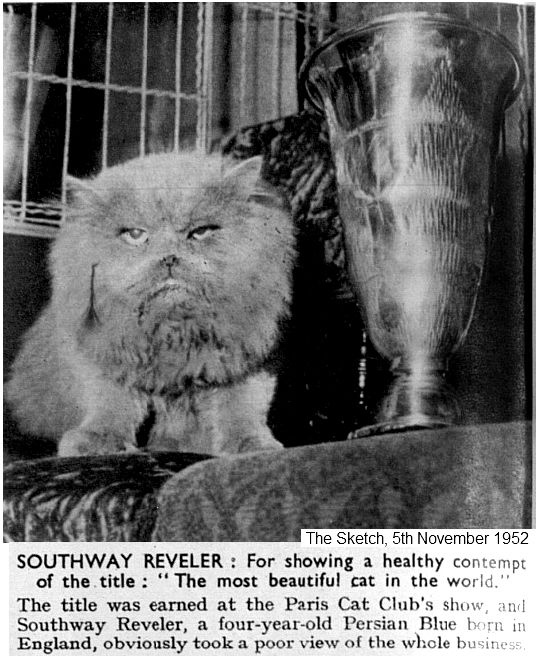
[1952 PARIS CAT SHOW] TO JUDGE AT PARIS CAT SHOW. INVITATION TO BRAMCOTE WOMAN Nottingham Evening Post, 4th October 1952
A Bramcote woman is to fly to Paris to judge the Blue Persians at the international show of the Cat Club de Paris. The judge is Mrs. Doris Bricewood-Webb [Brice-Webb], of 294 Chilwell-lane, Bramcote, who is an expert on blue, cream, and blue-cream Persians. To-day she received a letter from the secretary of the Paris club, inviting her to judge at the Paris show on October 24th to 26th. Cats from all over Europe will be present. The invitation means that Mrs. Bricewood-Webb becomes an international championship judge. She will make the air-trip with another British judge, Mrs. Aitken, of Banstead, Surrey.
[PARIS CAT SHOW] THESE CATS WERE ON VELVET Nottingham Evening Post, 28th October 1952
After a bumpy air crossing, Mrs. E. B. Webb, the Chilwell cat breeder, arrived home from the International Cat Show in Paris last night. She said: "I have judged scores of shows but never have I experienced anything approaching this one. For staging and presentation, there is no show to approach it in England."
Kittens seated on velvet cushions in brightly enamelled cages; Siamese cats in miniature bedrooms complete with furniture and chandeliers - that was how some of the 300 cats from all over Europe were presented. Mrs. Webb judged the Blue Persian entries, and saw one of her breeding win the second champion female prize. She sold the kitten over two years ago to the sister of the owner of the champion cat in the show, Southway Reveller, which was also of English breeding. The champion was sold by Mr. J. H. Amos, of Sleaford, to the present owner, an American woman who lives in Switzerland.
[PARIS CAT SHOW] Sunday Mirror, 16th November 1952
A cat wearing a light yellow sweater and dark glasses, and smoking a cigarette, was among 200 entrants in a Paris cat show yesterday.
[PARIS CAT SHOW] SMOKING CAT Whitstable Times and Herne Bay Herald, 22nd November 1952
Entered in a Paris cat show last week, Yoghi wore yellow sweater, dark glasses, smoked a cigarette. Yoghi did not win a prize!
[PARIS CAT SHOW] LAST OF HIS LINE IS A CHAMPION Newcastle Journal, 26th October 1953
A British blue Persian, Myowne Gallant Homme, was named as "Mr. Europe" of the cat world in Paris yesterday. His French owner, Madame A. Mariani, received a Sevres vase given by President Auriol, and Myowne, his ordeal over, promptly went to sleep. The three-year-old winner, last of a long line of illustrious felines, capped a series of victories at British cat shows with his Parisian success. The show's best kitten, also of British parentage, was a five-month-old Blue Persian. His father also walked off with a first prize. The winners were chosen from 300 cats taking part in the 27th international show organised by "Le Cat Club de France" in a Paris hotel. Three British women, Miss Kathleen Yorke, Mrs Marguerite Wize, and Mrs Lily Speira, were judges.
